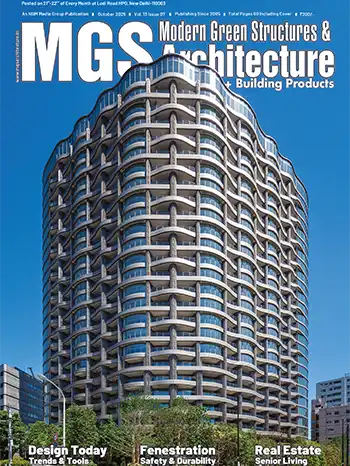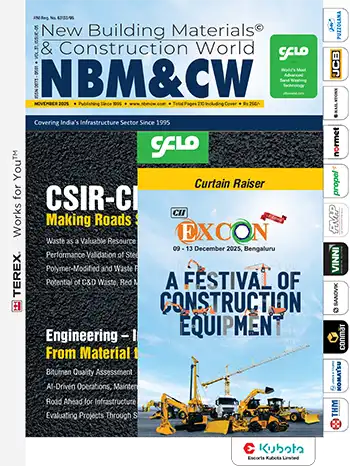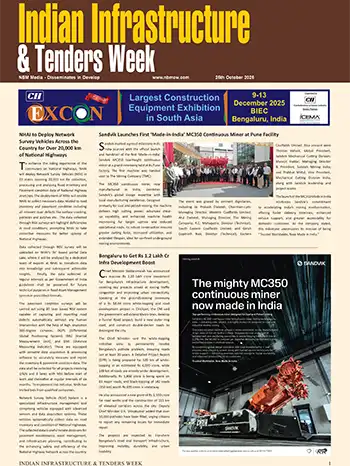
Water Droplet Resort
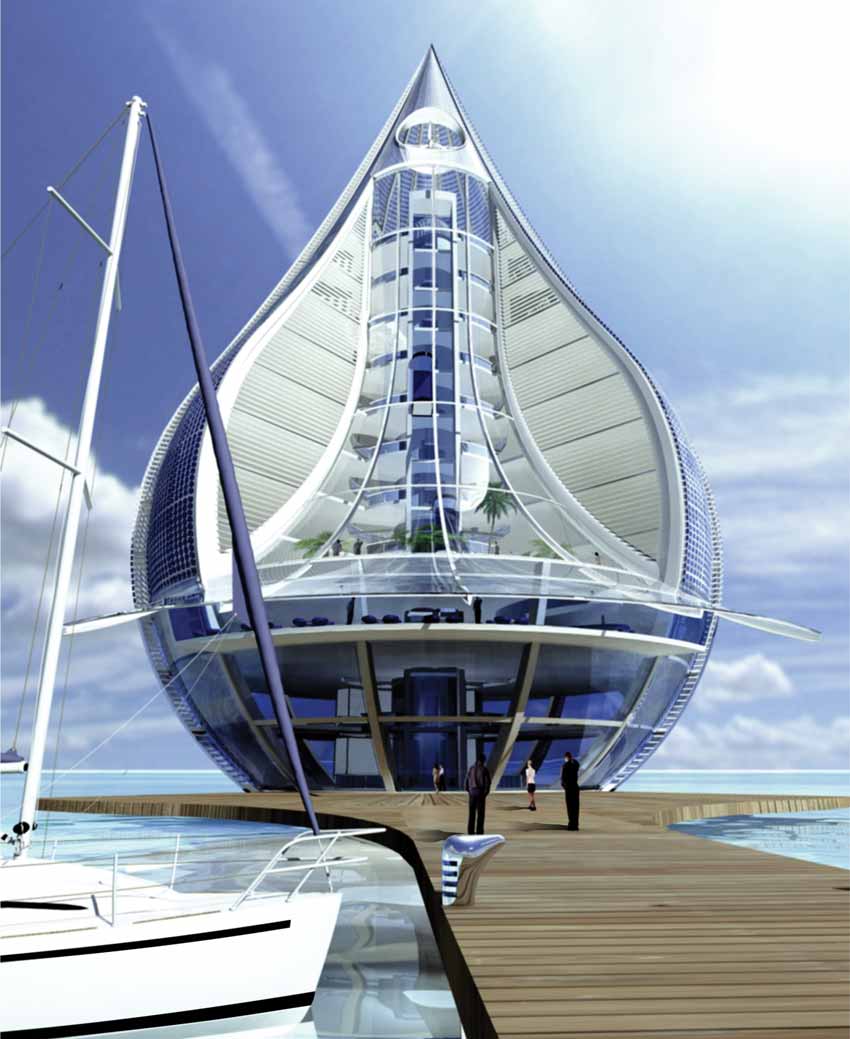
Hi-tech and architecturally designed Water Droplet Resort not only contribute to the knowledge and culture of the coming generations, but also adds to the financial returns of its promoters and investors.
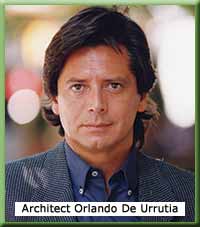
Based on an innovative concept 'Water Droplet resort' is an architectural marvel that has been designed in the shape of water drop by Orlando De Urrutia. It is the first building of its type which converts air into water with the help of solar power. It sounds unbelievable or magic but is true! The concept to design the building is nothing but a combination of technology and nature.
Inspired by the form of a drop of water falling from the heights, the building is projected and thought to create conscience of the water. Designed for construction in warm and humid coasts, the Water Building Resort, will house an aquarium, Restaurant, Gyms, Hotel, Spa services, Convention Halls and Conference rooms. Moreover, the bottom floor of this resort complex will have a water treatment zone for purifying rain water and salty sea water and a technological investigation center to control and verify water quality. The building also incorporates a technology research center (Cidemco) which controlled certification of quality industrial products.
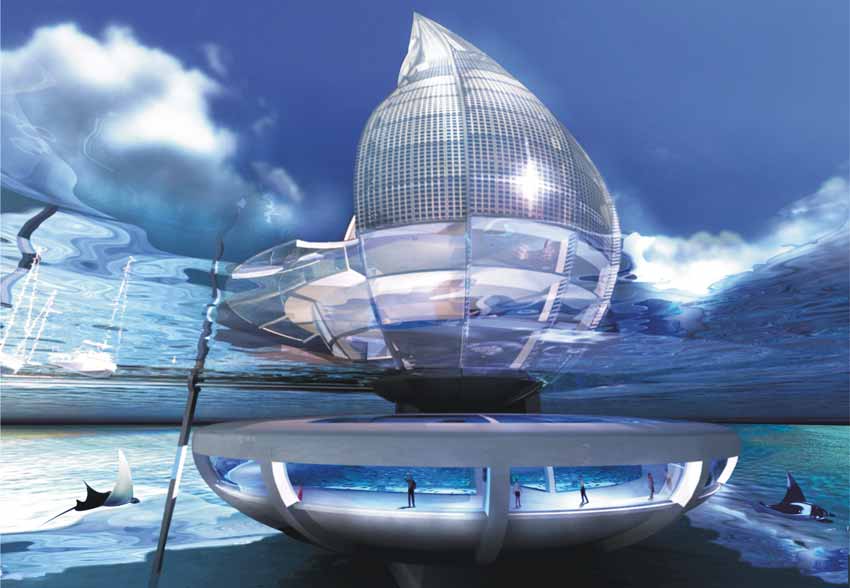
The building design allows the integration of renewable energy uptake and energy optimization. The sun-facing facade is covered with photovoltaic crystals latest technology that allows transparency and energy to capture the electricity of the building.
The facade opposite the sun are shutters that allow air to enter which is conducted through the water producing equipment. The air passing through the central courtyard is speeding up and out the upper wind turbine, generating electricity for all teams abasteceder.

Water Building Resort, will be the first build in the world that transform the air into water, starting to obtain water from the air it seems to science fiction, however it is a reality thanks to new technology and modern TeexMicron incorporated in this building.

Their production based on the condensation of the humidity that is in the air, its location in the water of the sea, add a big value regarding a bigger condensation. Allowing to take advantage of the night daily evaporation and condensation.
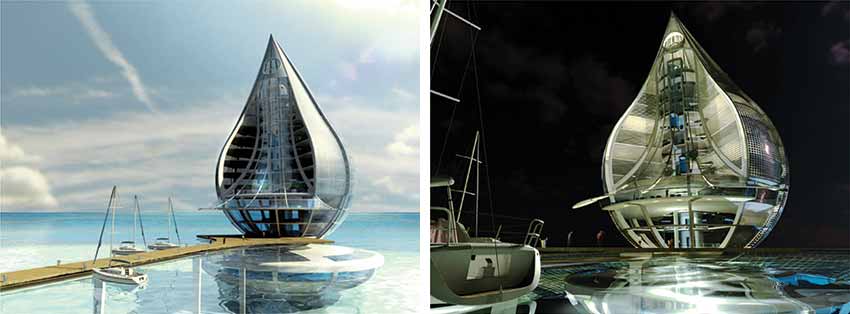
Moreover, Building Water Resort recycles water from rain and purging with marine desalination equipment incorporated in the base of the building. Water generators "TeexMicron" capable of producing 5,000 liters of water per volume of 21.17 m3 team, 48 people, for the calculations we use an average of 105 liters per person.

Dragonfly Future Metabolic Farm for Urban Agriculture
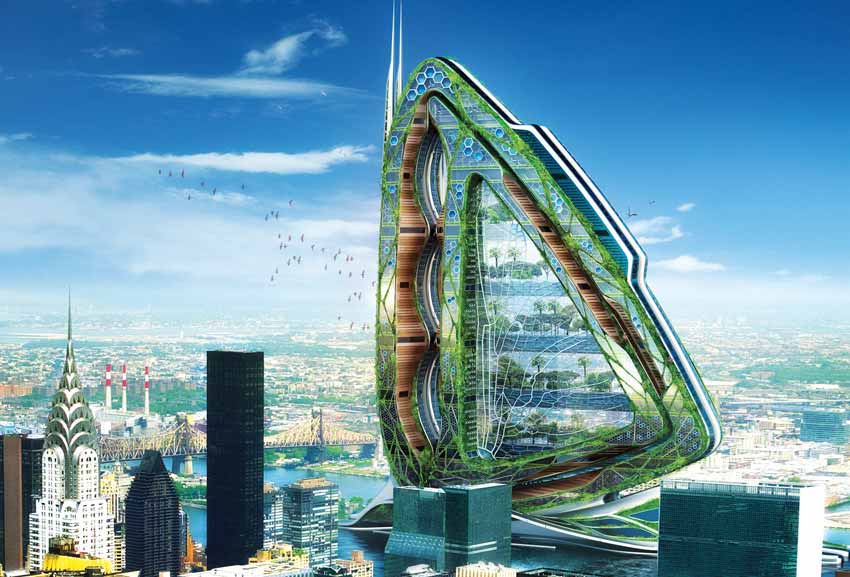
Dragonfly, the 21st century Metabolic Farm for New York City has been designed with the intention of easing the ever-increasing need for ecological and environmental self-sufficiency in the urban cityscape.
Belgian firm Vincent Callebaut Architectures have designed a vertical farm based on the wings of a dragonfly. Proposed for the East River at the south edge of Rooselvelt Island in New York City, the tower is a true living organism being self-sufficient in water, energy and bio–fertilizing. Spanning 132 floors and 600 vertical meters, the dragonfly can accommodate 28 different agricultural fields for the production of fruit, vegetables, grains, meat and dairy.
This Dragonfly wing shaped superstructure features wind and solar power producing capability and includes housing, offices, research labs and communal areas separated from farms, orchards and production rooms. Throughout the glass and steel set of wings, animal and plant farming is arranged as well as soil nutrient levels are maintained properly.
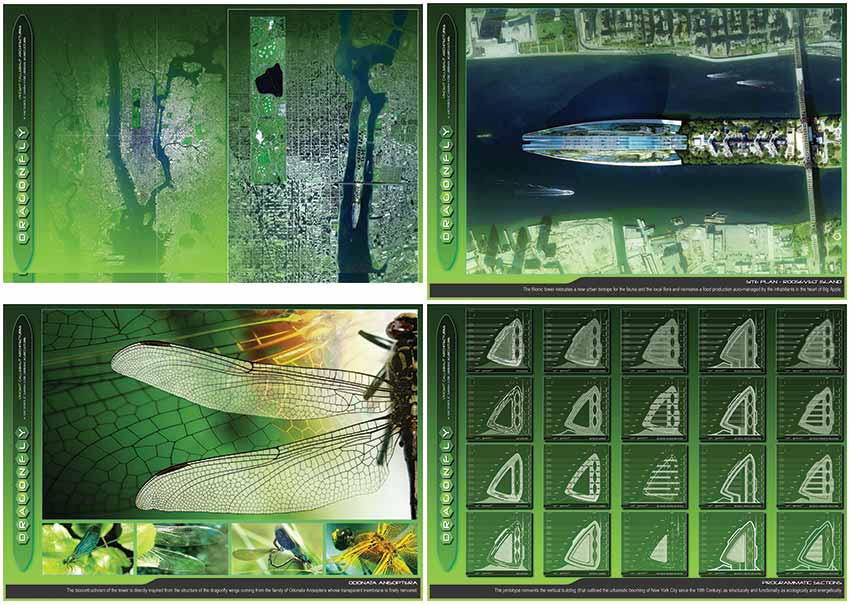
Food Challenge of the 21st Century
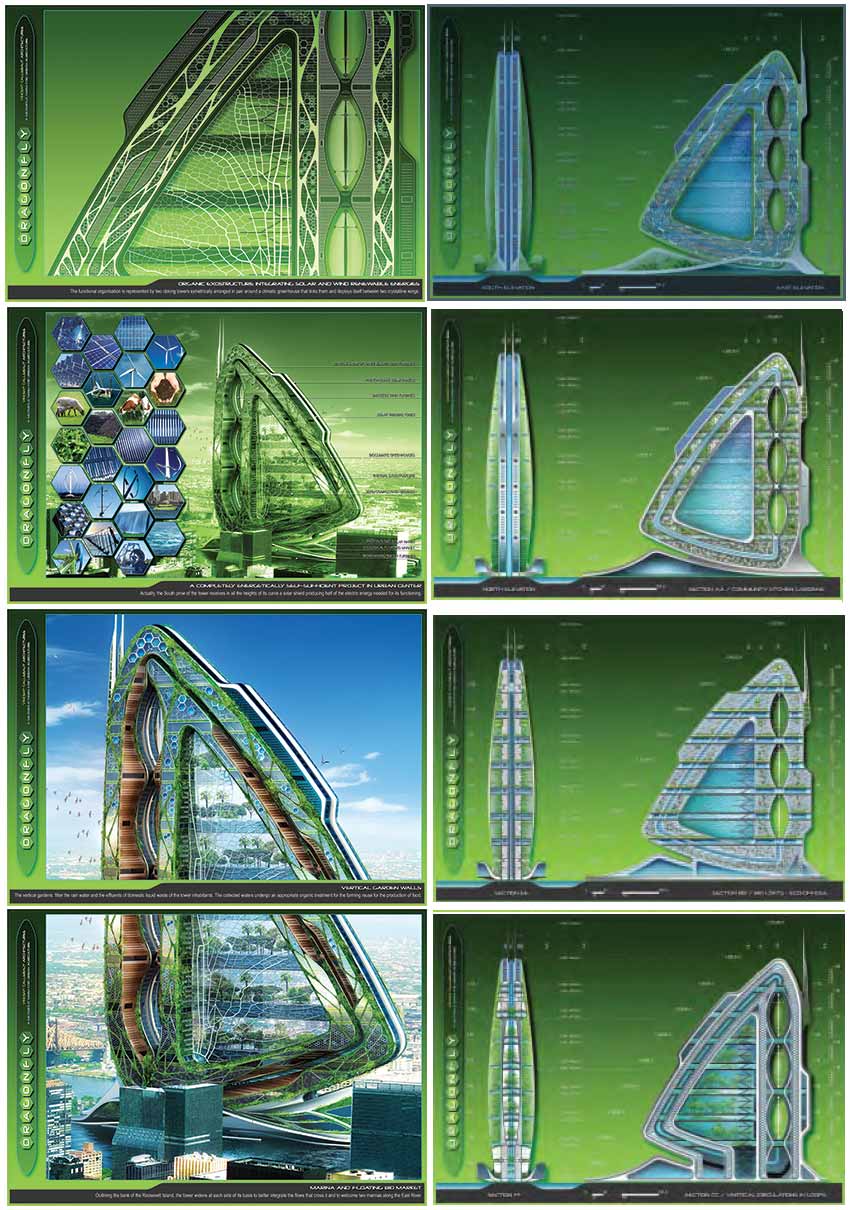
According to the PNUD (Programme of the United Nations for the Development), the worldwide urban population will go from 3.1 billion of inhabitants in 2009 up to 5.5 billion of inhabitants within 2025. Looking for a positive energetic assessment, the contemporary city aims within fifteen years at producing cleanly and intensively more energy than it consumes so as to pack this urban exodus! It develops therefore the urban agriculture to become food self-sufficient by recycling at the same time its liquid waste by phyto-purification, its solid waste in fertilizers by composting and by producing energy by biomass, photovoltaic cells and other renewable energies (thermo solar, photovoltaic solar, wind, tide-turbine energies…).
In order to avoid the asphyxiation of the planet and the feeding of its 9 billion of inhabitants within 2050, it deals thus with reinventing the traditional energetic pattern between the city and the countryside between western countries, emerging countries and developing countries. This sum up as following: on the one hand import of natural and food resources, and on the other hand export of waste and pollution. The ecologic city aims at reintegrating the farming function on the urban scale by emphasizing the role of the urban agriculture in the use and the reuse of natural resources and biodegradable waste so as to close the loop of ecologic flows.
The urban agriculture can feed the city without any pesticide or chemical fungicide (whose toxicity is proved on the human being: cancer, sterility…), and make it less food dependant of its backcountry or other regions of the world. Organizing the distribution of fresh products in short circuits, that means linked directly with the consumer, the urban agriculture complete thus the traditional agriculture. In addition to the nutritive quality of the produced and consumed food, the urban agriculture is also a growth lever of the urban unemployment market and the local economy. It is used directly as a social link in the conciliation of the primary needs of the newcomers with the challenge of their integration in the life of the city, fighting thus against poverty and exclusion. On the sanitary level, this farm approach presents also an interesting potential for the decontamination of polluted grounds and undergrounds as well as for the purification of the polluted atmosphere.
Dragonfly, a Nourishing Vertically Cultivated Central Park
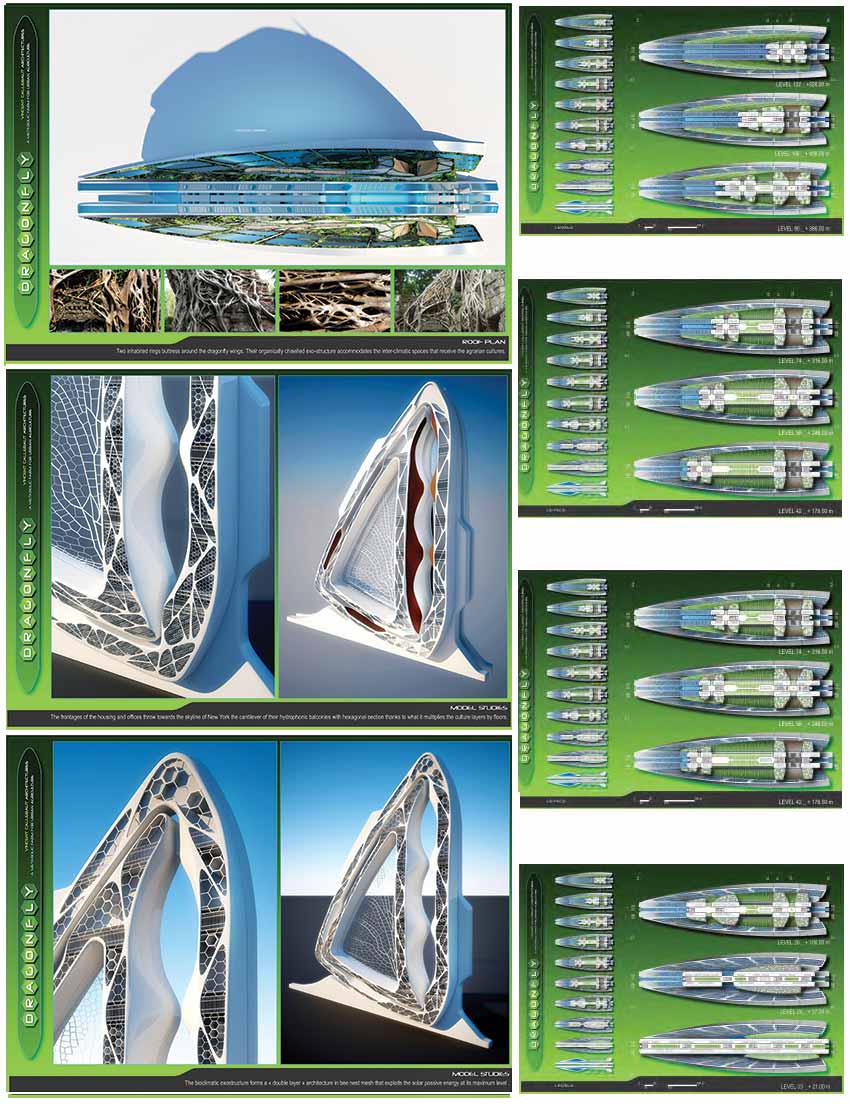
The architecture has to be in the service of this new agriculture and to design this new social desire in this context of ecologic mutation and food autonomy! The Dragonfly project suggests therefore building a prototype of urban farm offering around a mixed programme of housing, offices and laboratories in ecological engineering, farming spaces which are vertically laid out in several floors and partly cultivated by its own inhabitants. This vertical farm sets up all the sustainable applications in organic agriculture based on the intensive production varied according to the rhythm of the seasons. This nourishing agriculture is furthermore in favor of the reuse of biodegradable waste and the keeping of energy and renewable resources for a planning of ecosystemic densification.
In order to conceptualize this project and give our point of view in the ecological and social crisis debates, Dragonfly sets up along the East River at the South edge of the Rooselvelt Island in New York between Manhattan’s Island and the Queens’ district. So as to face the land pressure, Dragonfly stretches itself vertically under the shape of a bionic tower relocating a new urban biotope for the fauna and the local flora and recreating a food production auto-managed by the inhabitants in the heart of the Big Apple.
Floor by floor, the tower proposes not only stock farming, ensuring the production of meat, milk, poultry and eggs but also farming grounds, true biological reactors continuously regenerated with organic humus. It diversifies the cultivated varieties to avoid the washing of stratums of soft substratum. Thus, the cultures succeed one another vertically according to their agronomical ability to provide some elements of the ground between the essences that are sowed and harvested.
The tower, true living organism, becomes thus metabolic and self-sufficient in water, energy, and bio-fertilizing. Nothing is lost; everything is recyclable to a continuous auto-feeding!
A Bionic and Energetically Self-sufficient Architecture
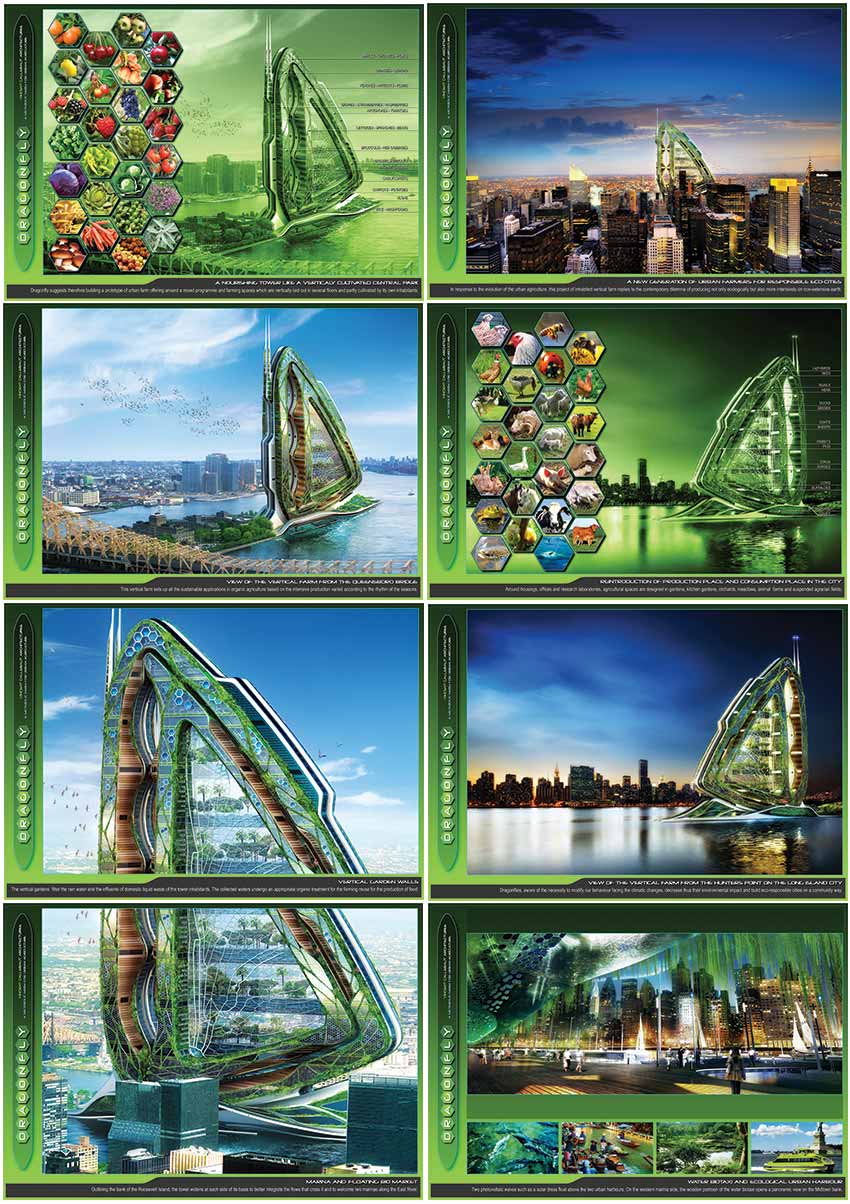
The architecture of Dragonfly prototype suggests reinventing the vertical building (that outlined the urbanistic booming of New York City since the 19th Century) as structurally and functionally as ecologically and energetically.
To ensure the social diversity and a permanent life cycle (24h/24) in the tower, the mixed plan is mainly laid out around two poles of housing and work places. Around housings, offices and research laboratories as well as the most private to the most public agricultural and leisure spaces are designed in gardens, kitchen gardens, orchards, meadows, rice fields, farms and suspended fields. The distribution of flows is made around a true safe spine spreading in loop the numerous elevators, the goods elevators and stair wells serving all the levels by separating simultaneously the inputs and the outputs recycled from plants, animals and human beings.
Architecturally, the functional organization is represented by two 600 m towers symmetrically arranged in pair around a huge climatic greenhouse that links them and deploys itself between two crystalline wings. These very light wings in glass and steel retake the loads of the building and are directly inspired from the structure of the dragonfly wingscoming from the family of "Odonata Anisoptera" whose transparent membrane is very finely nervured. Two inhabited rings buttress around these wings. Their organically chiseled exo-structure accommodates the inter-climatic spaces that receive the agrarian cultures.
The whole set forms double layer architecture in bee nest mesh that exploits the solar passive energy at its maximum level, by accumulating the warm air in the winter in the thickness of the exo-structure, and by cooling the atmosphere by natural ventilation and by evapo-perspiration of the plants in the summer. Protecting thus the cultures from climatic changes inNew York (from -25.5°C in the winter to +41°C in the summer), these plug spaces are useful to reflect on the agriculture not anymore in terms of surface area but really in terms of volume. Actually, whereas grounds nourish orchards, each wall and each ceiling are metamorphosed into three-dimensional kitchen gardens. The interior frontages of the housing and offices throw towards the skyline of New York the cantilever of their hydrophonic balconies with hexagonal section thanks to what it multiplies the culture layers by floors. The vegetation abounds, the earth is swarming of insects and animals are freely brought up in holding tanks by urban consumers with low income. The architecture becomes eatable!
In addition to this thermal called passive system, the integration of renewable energies has been thought from the design of Dragonfly to meet the needs of a completely energetically self-sufficient project in urban centre. Actually, the South prow of the tower receives in all the heights of its curve a solar shield producing half of the electric energy needed for its functioning. The other half is ensured by the three wind machines with vertical axes of Darrieus type that coils itself up in the three lenses hollowed in the North part of the micro-pearled shell towards dominated wind of New York. The exterior façades of the tower present a double personality. Actually, in the West of the Island near Manhattan, the façades are treated in planted walls, whereas in the East near the Queens’ district, the wet exterior walls are cultivated with tropical essences. These vertical gardens enable to filter the rain water and the effluents of domestic liquid waste of the tower inhabitants. The collected waters undergo an appropriate organic treatment for the farming reuse, bringing all the nitrogen and an important part of phosphor as well as potassium needed for the production of fruits, vegetables and cereals.
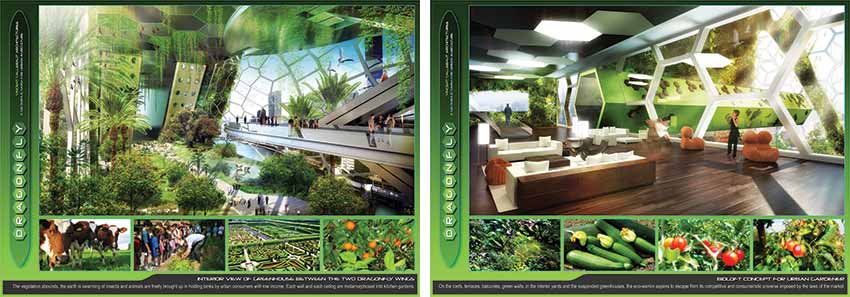
Outlining the bank of the Roosevelt Island, the tower widens at each side of its basis to better integrate the flows that cross it and to welcome two marinas along the East River. This widening out forms two huge photovoltaic vaults such as a solar dress floating above these two urban harbors: on the western marina side, the wooden pontoons of the taxi boats open panoramically on the Midtown bank and on the eastern marina side, the floating market oriented towards the Queens’ district is designed to distribute through the river the food production of this vertical farm to the heart of Manhattan and to its million and a half of city slickers. Moreover, these two marinas accommodate two huge aquaculture ponds, true tank of soft water filtered by the planted frontages and dedicated to be reinjected in the hydroponics network of the Dragonfly tower.
According to the evolution of the urban agriculture enhanced by the FAO (Food and Agriculture Organization of the United Nations) that has been realizing since 2007 that the organic agriculture on a large scale would be able to nourish the planet, the Dragonfly project challenges the city of New York to rethink its food production. In response, this project of inhabited vertical farm replies to the contemporary dilemma of producing not only ecologically but also more intensively on non-extensive earth. This by merging also directly production place and consumption place in the heart of the city!
| Project Details | |
| Project | : A Metabolic Farm for Urban Agriculture |
| Location | : Roosevelt Island, New York City, USA |
| Surface Area | : 350.000 m² |
| Heights | : Antenna=700m; Roof=600m; Top Floor=575m |
| Floors | : 132 |
| Agricultural Fields | : 28 |
| Model Studies | : Philippe Steels |
| Perspectives | : Benoit Patterlini |
| Architect | : Vincent Callebaut Architectures |

Valmy Footbridge An Architectural Marvel
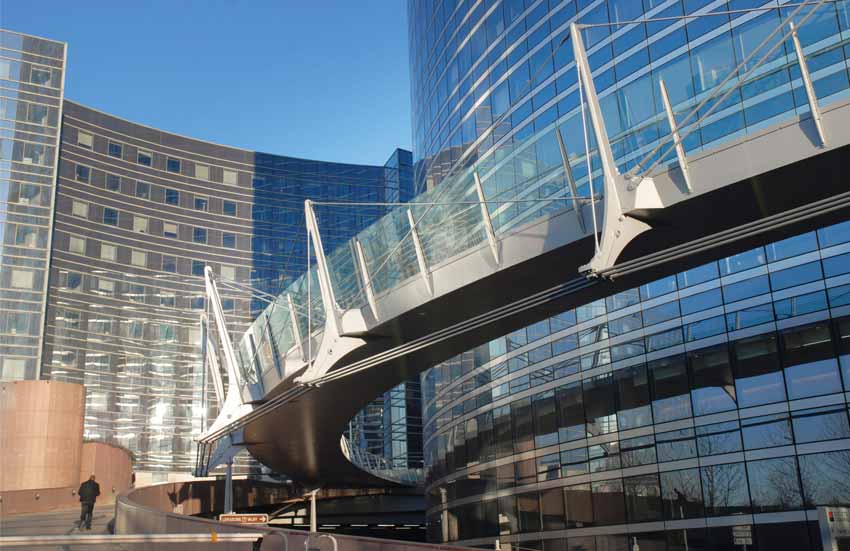
Linking the west part of the Parisian financial district La Defense with the city of Nanterre via the recently erected highrise building "Tour Granite", this 90m long footbridge winding through a dense architectural tissue is a modern urban promenade based on an ambitious structural concept.
The client – EPA Seine Arche – is an institution in charge of developing the public space between La Défense and Nanterre. During an architectural competition in Paris, the project of the architect Dietmar Feichtinger has been chosen. Dietmar Feichtinger is also an architect of the Simone de Beauvoir footbridge in Paris and the 3 countries bridge in Huningue. For the Valmy footbridge he was assisted by the engineers Schlaich, Bergermann und Partner (Stuttgart).
A suspended architecture between the buildings of La Défense
Starting off behind the Grande Arche as a ramp continuing the general level, the generous circumscription of the office building of the Société Générale Bank - visible in plan - asked for a specific solution. The architectural ambition for lightness and transparency is obtained by a balance of forces. The structural functions – tension and compression are clearly expressed. The dimension of each element is minimized. The organic and soft shape of the structure – close to the pedestrians – is in opposition to the monumental scale and the "cold" abstract expression of the highrise buildings.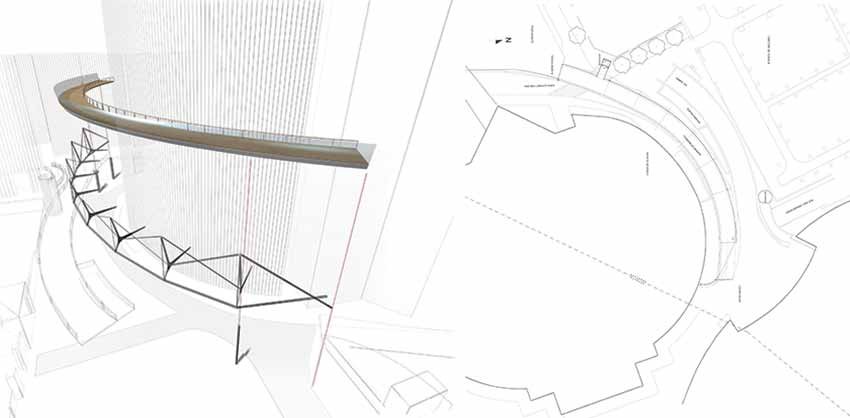
The bridge keeps a large distance with the building and the supporting structure has been transferred to the exterior curve. This allows obtaining a maximum of natural light for the offices and the cafeteria. The bridge attains the "Tour Granite" on the first floor. Escalators and stairs link up with the ground level in the city of Nanterre.
The rhythm of the structural elements assures the identity of the bridge. The main structural elements are the girders accentuating the bridge every 10 m as the "spinal column" of the bridge. The deck consists of a steel sheet box girder. The radiating "spine elements" are interconnected by pre-stressed cables. A system of cantilevers takes on the vertical forces. Resistance against torsion is assured by the deck and retaining cables below pre-stressed in the circumferential direction. The walking surface of the deck is covered with a uniform dark grey epoxy resin. The continuous surface opposes the stone pattern of the existing platforms and reinforces the impression of the bridge as a link.

The railings are composed of pre stressed horizontal steel cables and a tube of stainless steel as handrail. The posts are made of 2 parallel steel plates including fixation for the light. Functional light is assured by fluorescent tubes vertically installed with each post and covered by a perforated stainless steel protection sheet. Glass screens as wind shields are fixed at the exterior curve so that the pedestrian may contemplate the cityscape. At night the illumination of the masts emphasizes the rhythmic structure of the promenade.
Structural Design

One can compare the structure of the Granite-footbridge with a spinal column: each element participates actively to assure stability creating a balance of tension and compression forces achieving maximum lightness: the spinal elements ("masts"), cables and the bridge deck.
The deck is formed by a steel beam, an element forming a trapeze in section - 4,5m large, 600mm high on the exterior and 300mm high on the interior edge. The beam is composed by welded steel plates, S355, reinforced with transversal stiffeners.
The spinal elements are made of steel plates, S460. They are oriented towards the center of the curved geometry of the deck. The main plates are stiffened by perpendicular plates welded to the main plate forming a cross section responding to compression forces.
The diagonal suspension cables link the spinal elements to the deck. All three elements compose the "spinal column" of the bridge. The retaining cables are anchored to the deck at the two ends. 3 monotoron cables of a diameter of 65mm are fixed to the spinal elements under the bridge deck. Prestress is induced during the mounting process.
Supporting Elements
The bridge is supported on each end by a combination of 2 anchoring elements fixing the beam: On one side the bridge is supported by a pile and anchored in the concrete slab of the existing platform, on the other side it is supported by 2 piles.The suspension structure – spinal elements and suspension cables – supports the vertical forces. It is positioned asymmetrically to the deck beam. Forces are being transmitted from the centre to the anchorage on the 2 ends. The closer one gets to the supports the stronger are the forces in the cables. This is why the number and the diameter of the cables as well as the height and the cross section of the spinal elements increase towards the supports.
Torsion is created by the curved geometry in plan and the asymmetrical layout of the supporting structure. Retaining cables are being installed under the bridge deck linking the spinal elements to balance torsion inducing a horizontal force. The curved layout and the inclination of the upper part of the spinal element demand transversal stabilisation. A vertical cable linking the two ends of each spinal element responds to this effort.
The bridge deck is as light as possible and responds to flexion and torsion. A lift gives additional access to the bridge linking the street level to the deck.
| Project Details | |
| Project | : Footbridge Valmy |
| Location | : France |
| Client | : EPA Seine Arche |
| Architect | : Dietar Feichtinger Architectes (DFA) |
| Team | : Christian Wittmeir, Guy Deshayes |
| Engineers | : SBP, Stuttgart |
| Aerodynamic studies | : PSP Aachen |
| Contractors | : Steel construction : VIRY SA |
| Fondations GTM | |
| Pre-stressing Electricity : Meurant | |
| Size and main features | : Length |
| Total length 90m | |
| Length without ramp Valmy 78m | |
| Clear Span 48m | |
| Width 4,5 m | |
| Weight | |
| Steel Construction 300t | |
| Reinforced Concrete 35m3 | |
| Excavation on Site 26m3 | |
| Tension Elements | |
| Tension rods 302m | |
| Section of Tension Rods 36~90mm | |
| Ring Cable / Cables 3x 75 m | |
| Strength of ropes 65 mm | |
| Height above street level 6 - 8 m | |
| Wind Screen (curved glass) 141m2 | |
| Time Schedule | |
| Competition | : 12/2003 |
| Start of Planning | : 2004 |
| Start of Construction | : 2006 |
| Completion | : July 2008 |
| Building Costs | : 2.8 Million € |
| Photo Credit | : Antonin Chaix |
Bridge Mounting
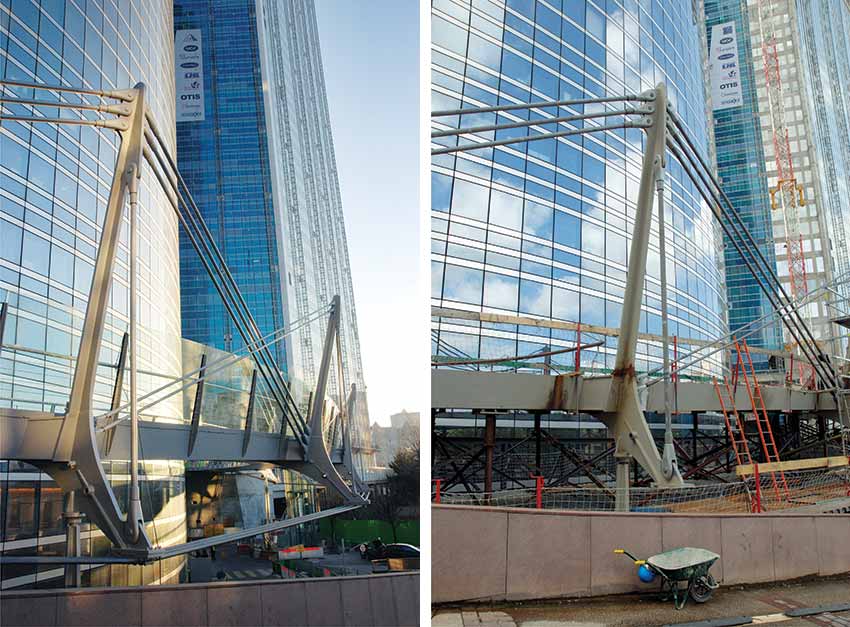
The bridge deck is composed by 26 prefabricated elements delivered on site by special transport. The elements are installed during the night on a temporary support, keeping the street on ground level accessible all time. The deck elements are positioned taking into account a counter curvature and welded one to the other obtaining a 90m long continuous deck.
The deck is positioned on temporary supports allowing readjustment of the geometry necessary due to deformation during the welding process.
Tension elements – suspension cables and retaining cables – are fixed on the spinal elements with connectors inducing tension and prestress. The retaining cables are tensioned by pulling the preinstalled cables towards the exterior curve. Special adaptors are fabricated to allow a step-by-step process. Jacks pull the cables into their final position. After positioning the retaining cables, the temporary support can by dismounted. The bridge takes its final structural state.
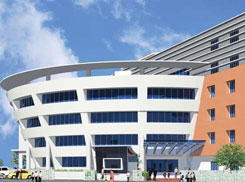
Trinity World School, Mumbai

| Project | : Trinity World School |
| Location | : Navi Mumbai |
| Site area | : 3930 sqm (excluding the playground) |
| Built-up area | : 9230 sqm |
| Clients | : NMMC |
| Architects | : THE FIRM |
| Principal Architects | : Sundeep Gwash, Vishal Shah |
| Project Team | : Kedar Dalvi, Trushali Gandre, Chaitali Amin |
| Sustainability | : Deepika Batra Gwash |
| Category | : Educational |
Located in Navi Mumbai this educational facility, Trinity World School is designed by THE FIRM for the client NMMC (Navi Mumbai Municipal Corporation). According to the client's brief, the facility had to be exemplary in terms of not only its facilities but also its level of design.
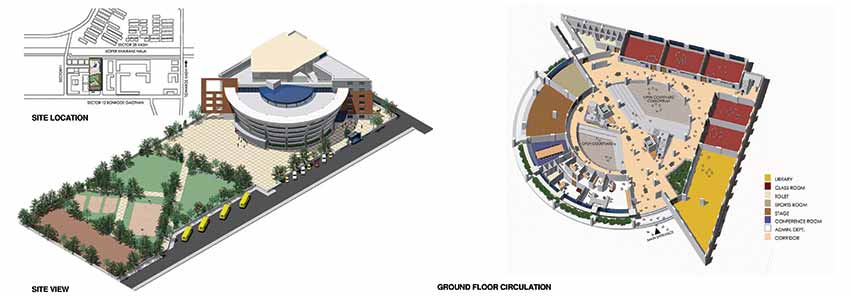
This facility is designed to provide learning spaces for children from kindergarten to high school, as well as the junior college of arts, science and commerce, and the state - of - the - art auditorium, besides many other activity zones.

The courtyard - centric design of the educational architecture focused on creating the ideal environment for learning by lieu of spatial relationships, indoor - outdoor relationships, natural ventilation and daylight and hub - of - activity areas.
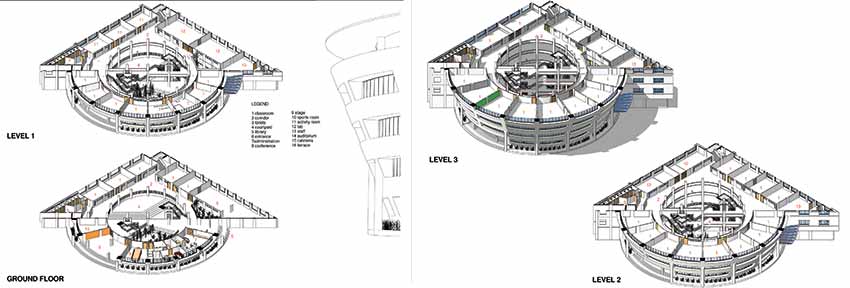
The building shape is derived to get maximum diffused light into the classrooms, and the resultant smaller footprint also lends more green area on the ground. The atrium brings in natural light to the courtyard and the scene witnesses various changes with the changing sun path during the day. The numerous solar studies at various important sections and courtyards views were being synthesized to improvise the design. The semi - open spaces on each level are intended to capture cross - ventilation, hence increasing the comfort level of the occupants. The micro - climate of the courtyard contributes to the visual appeal, and helps in creating better micro - environment at the same time.

The school auditorium is designed to be available for use by the larger community; hence the need for additional facilities goes down; saving costs community - wide and decreasing the environmental impact of the community as a whole.
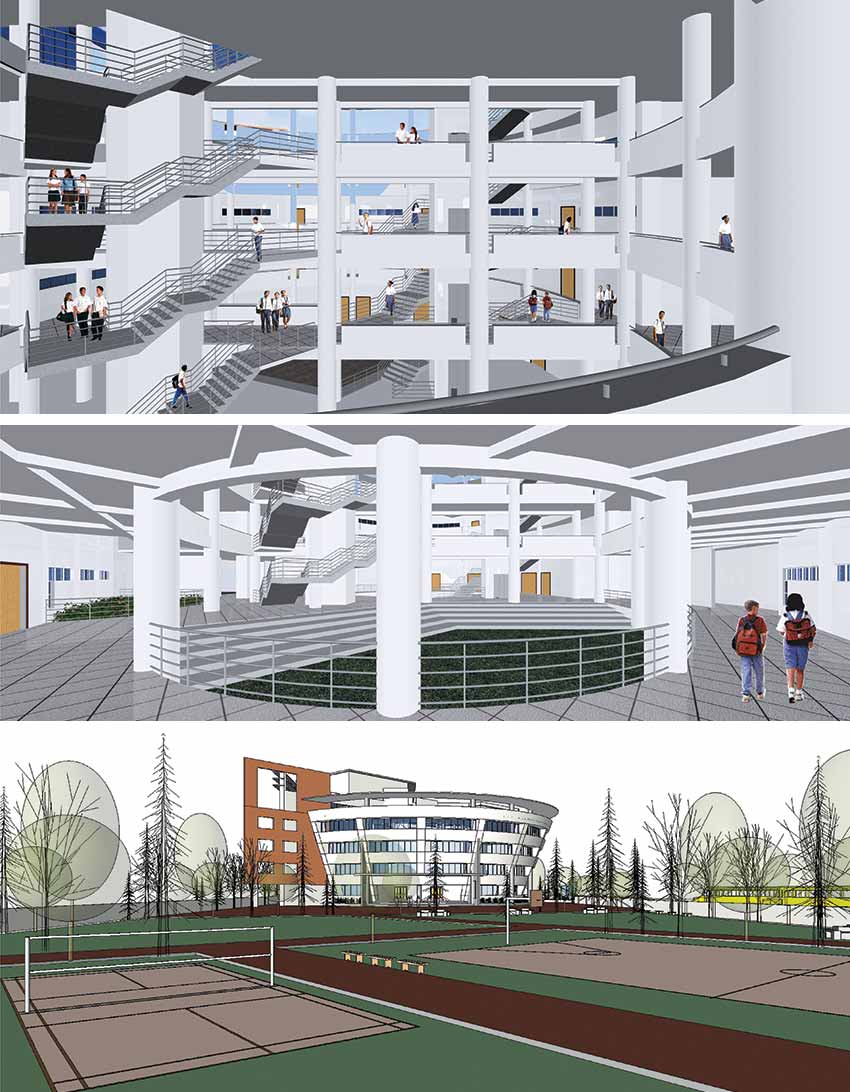
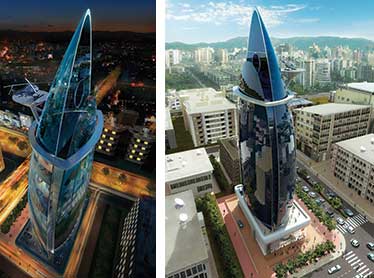
Signature Tower Mumbai
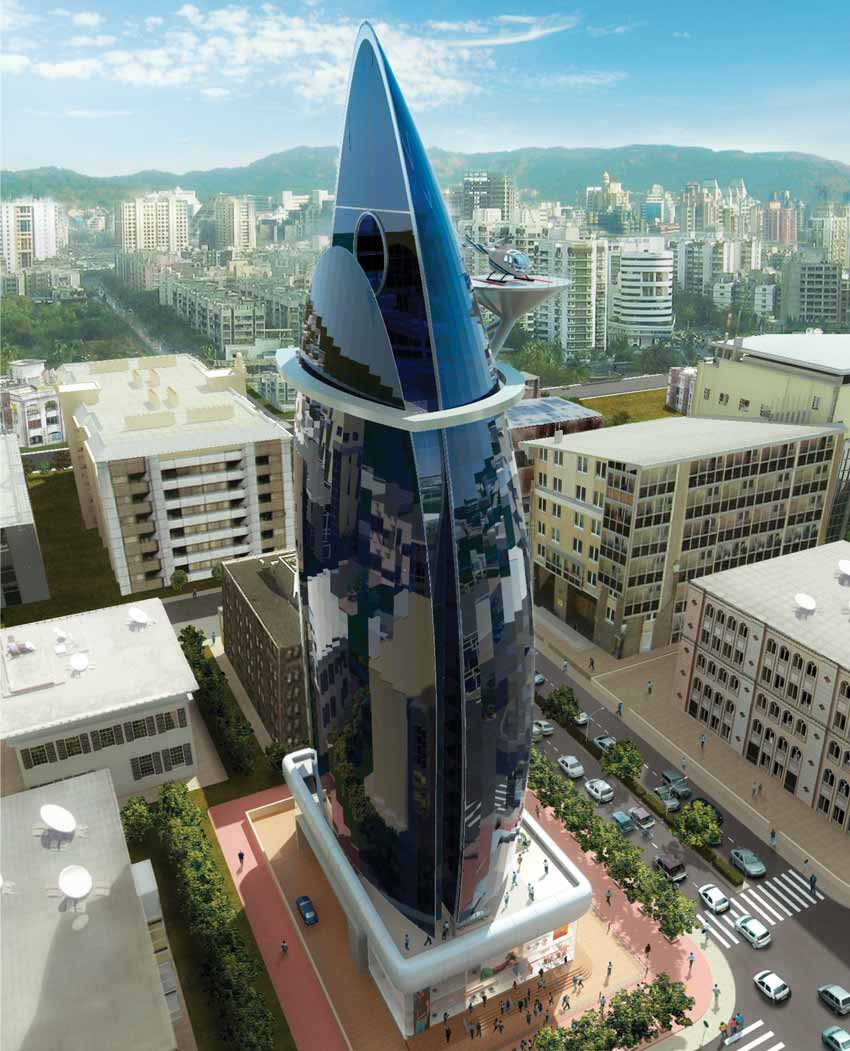
| Project | : Shah Signature |
| Location | : Navi Mumbai |
| Site | : 1800 sqm |
| Footprint | : 825 sqm |
| Built–up | : 13,000 sqm |
| Clients | : Shah Group Projects & Infraprojects Ltd |
| Architects | : THE FIRM |
| Principal Architects | : Sundeep Gwash, Vishal Shah |
| Project Team | : Kedar Dalvi, Trushali Gandre, Chaitali Amin |
| Sustainability | : Deepika Batra Gwash |
| Category | : Commercial |
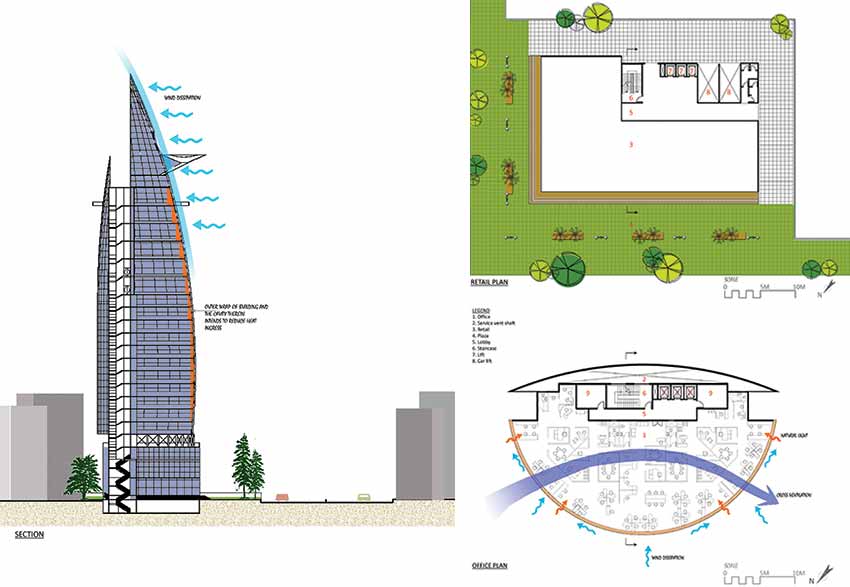
Designed by THE FIRM, the project 'Shah Signature' has been an interesting project in terms of its clients' ambitious design brief and the manifestation of the same into a very iconic architecture in the making.

The iconic sail form of the building signifies the local context in past and its futuristic bend in present context for the project site located in the twenty - first century city of Navi Mumbai. The form centric design was conceptualized for the project and it appealed instantaneously to the clients.
Various options were considered in pre - design stage and the design was finalized on the basis of concept and better energy performance vis-à-vis orientation and form.
A mixed - use highrise commercial building, the 'Signature Tower' comprises offices on the upper floors and the retail shopping activity in the lowers floors and basement. Being situated on a corner plot, the open space on the ground is being well - utilized to act like an open deck for public spill - over from the retail mall - a pleasant change for the crowded vicinity. The ancillary program includes multi - level parking with car lifts and fine - dine restaurants and a gym.
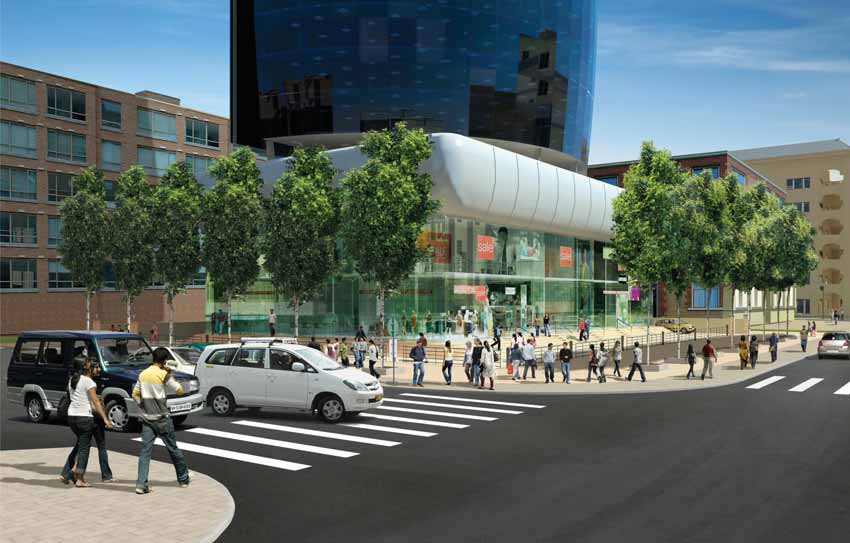
The salient features of the design include column - free spaces for offices, the high performance facade offering views and natural light deep into the office floors; and the exclusive roof - top office with the helipad.
The special façade structure is determined to be designed on a grid concept, lending it the two way curve form. The wrap form is also intended to act as an outer layer of building envelope, reducing heat ingress but not daylight; thus minimizing the load on air - conditioning. The form compared with the regular box building is imposing but not unwieldy; and is more appropriate to handle winds at higher levels. The visualization of the curve building façade which was reducing in plan on going higher was done at various stages, till the time the satisfactory outcome was not achieved. The team is currently trying if the unique façade grid could be made parametric so as to accommodate change if the higher FSI is approved by the development control authorities. The structural consultant and MEP consultants are sharing the information from the BIM model in the form of 3d files, to bring out the integrated design in services and structures. The MEP services of the building are defined to be designed to go minimal on energy and water consumptions.
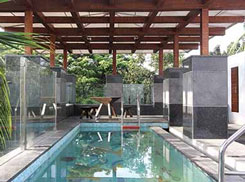
Narrayan's Jayamurghan Project
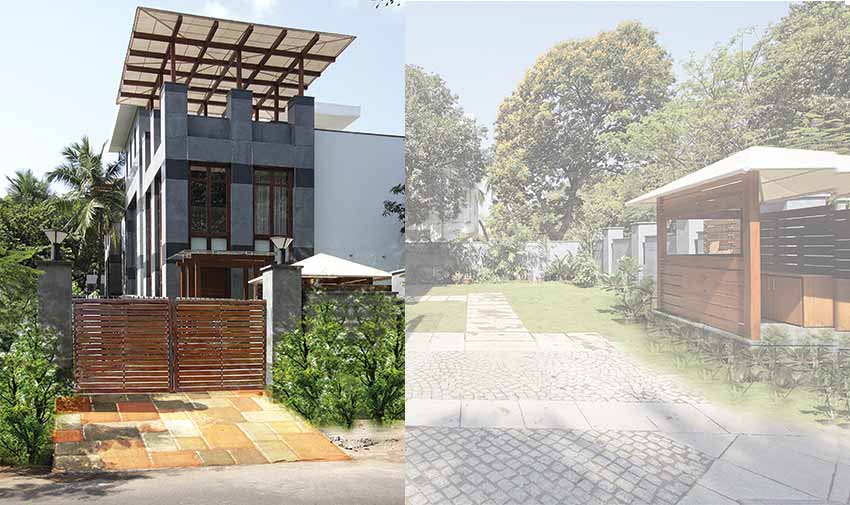
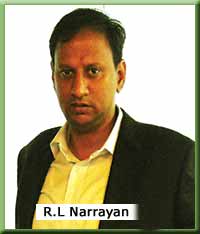
Architect Narrayan and Associates, a renowned architectural firm in Mumbai was started in 2000 by Architect R.L Narrayan with only two staff, has now grown into 70 professional staff within a span of 8 years only. Born in 1972 and completed his graduation diploma in architecture from Institute of Environmental Design, VVN, Mr. Narrayan commenced his career in 1997 with the firm Doshi and Bhalla.
Mr. Narrayan has won many prestigious awards such as 'Bhartiya Shiromanj Puraskar' in 2006 as an excellence for enhancing the image of India by Institute of Economic studies & development, New Delhi.
Also awarded as 'Architect for excellence (Business) award 2006' for his outstanding services to the society and excellence in the architectural field for Individual Achievement & nation building. In 2008, Mr. Narrayan has been honored by the award ''Bunts Sangha Mumbai' by honorable minister of agriculture.
The firm Architect Narrayan and Associates conceptualized, designed, and execute, projects ranging from corporate office, commercial, residential, malls, hotel & resorts, Institutional, hospitals and various other diverse fields in architectural/interiors. They are also involved in designing railway stations; urban planning and redevelopment projects and uses complete high technology and computer aided engineering tools.
The firm has completed many prestigious projects in and around the country. Some of its important clients are: Reliance Energy, Sahara Group of Companies, ICICI Bank, monster, Adlabs, Nelito, Kumar Builders, Business Solution Pvt Ltd, Writer, and so on. They are also doing many international projects in countries like Muscat, ShriLanka and UAE.
Architect Narrayan has recently completed a residential project in Chennai for the Client Mr. J.Jayamurghan who is professionally a businessman. According to Mr. Narrayan, when we first visited the site, the site seems to be in a complete scenic environment, with tall trees, greenery all across the neighborhood. Despite been in the middle of the city, it seems aloof from the city environment itself and to us it's a perfect plot for a villa, which should have this serene environment.
| Jayamurghan's Details | |
| Project | : J.Jayamurghan Villa, Chennai |
| Plot Area | : 1000 SM |
| Total Built-up | : 1600 SM |
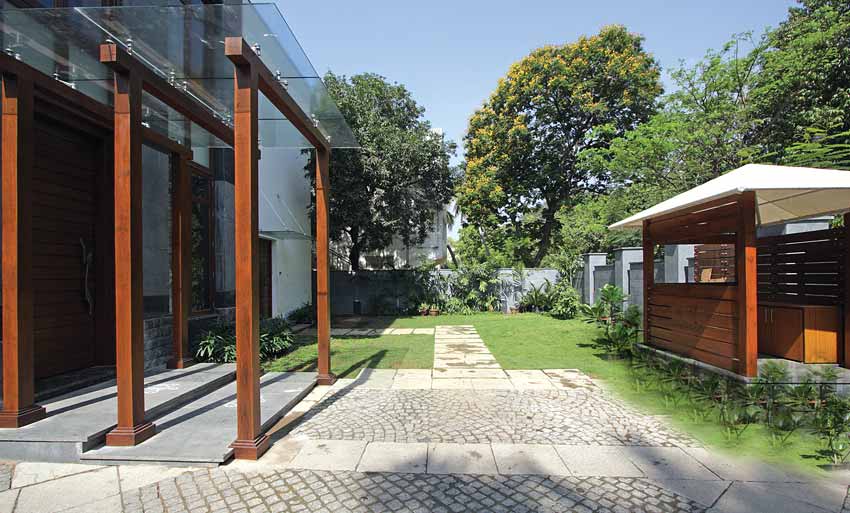
Before started working on the project, we first had the meeting with the client at his existing house. We have chosen the above said venue for meeting just to know the kind of environment he lives in, and we knew at the very offset that there should be a drastic change to the overall life style that he lives. We not only had to make sure that the traditional style of living should not be overlooked, but had to make sure that all the amenities of a modern and a high tech living had to be incorporated.

Design of Villa
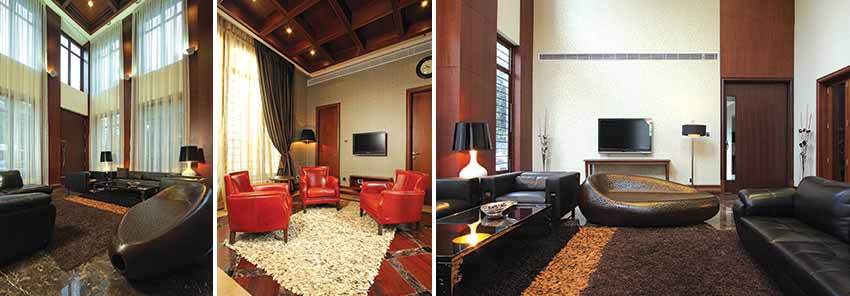
The plot was in a rectangular shape which had a narrow width; this affected the overall design, as the house became longitudinal in design, it was particularly difficult to save space from corridor. The brief given to us about the requirement of the inhabitants has to be completed fulfilled. The design of the villa should cater to all their needs. The space should have a lot of natural light, well ventilated and each room to be spacious. Most importantly, the house should be completely 'Vastu' compliant.
The building has been designed keeping the aspect of various flows of the privacies of the inhabitant. It has ground plus two upper floors. The ground has space for Formal living room, and an office attached to it. There is a formal dining area, family dining and kitchen, and it also has two bedrooms for senior citizen of the family. The whole layout revolves around the atrium in the middle of the house with an elegant metal / wooden staircase connecting the various levels. The first floor has four bedrooms with family room and a small study room, the whole space revolves around this atrium which has a tension rod patch fitted glass. So as this atrium is well lighted and looks spacious.

This atrium is more of a night space which has reflected light, and a lot of ceiling hanging lights, the whole space has a complete mood lighting system. As been a central space and the other rooms revolving around this, it has attraction which cannot be missed.
The second floor has been divided into terrace for parties and the recreational area such as theater room, gymnasium, a Small Spa which as steam and Jacuzzi, whereas the other half of the house has swimming pool attached with changing rooms.
Interiors
The interior has been designed to have a post colonial feel with a flavor of contemporary elements. The spaces in each area has high ceiling with quite a bit of diffuse lighting, this itself gave a very post colonial modernistic feel. The colors and textures been used in each area has a very versatile and a combination of traditional and modernistic feel, there has been use of lot of wallpapers which has floral as well as geometric design, keeping in mind the space that it envelopes, detail design in each room has been particularly looked at as an integral part of an overall design.
According to Associates Interior Designer Isha Narrayan, also the wife of Mr. Narrayan, "It was during the interiors that we had to look at the usages of the mix between traditional colors and modern aspect of the house. The house has a complete system of a BMS integration between, Air-condition, lighting, security and fire alarm system. It has also the most modern system in terms of efficiency of power consumption."
She further says, we have used centralized VRV system for the entire house, which has been specially designed and ordered from Japan, this has a complete integration with BMS System. The security system been used are of one of the most high-tech systems, with 14 cameras around the house, remote locking system and burglar alarm system.
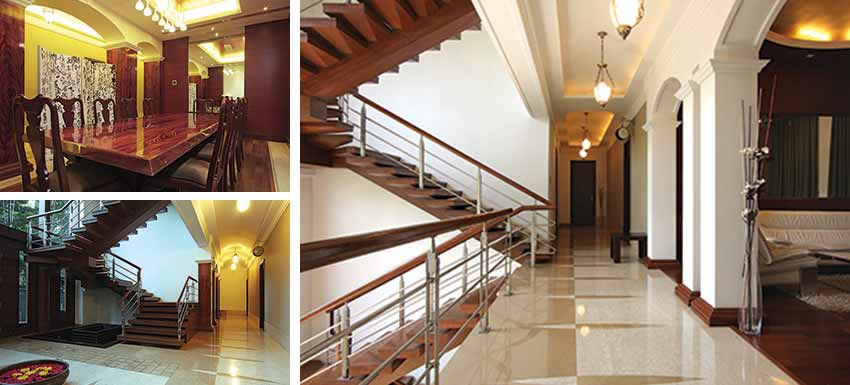
The Complete Villa was a minimalist design. Wooden Floor were used in all the Bedrooms which clearly reflects very warm, rich and spacious look.
The Pure wooden Stairs with Open steel railings depicts beautiful combination of classical and modern concepts— from the Ground Level, the Entrance view is breathtaking impressive as the complete staircase and 2 levels are viewed. The Open lobby gives a very inviting look with minimum seating on the entrance.
The wooden high ceiling with huge glass windows and high wall curtains in the family room creates a very welcoming ambience; the designed focus is on the wooden ceiling with interesting colors used in the family area maintaining the modern concept.

Isha says, "It is vital to understand Client's requirement for designing his House. We tried our best to clearly perceive his point of view. It is this practice that we always developed projects beyond the client's expectations."
The construction of the building took approx. one year for completion. The construction method has been a framed structure with usage of local material. The overall construction has been carried out keeping in mind the green building concept which has been applied at minute's details. The usage of shaded areas, the larger openings towards the east and the west side are kept with shading coefficient in mind.
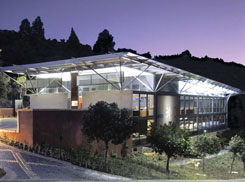
EPA Studio - Superb Steel and Glass Architecture
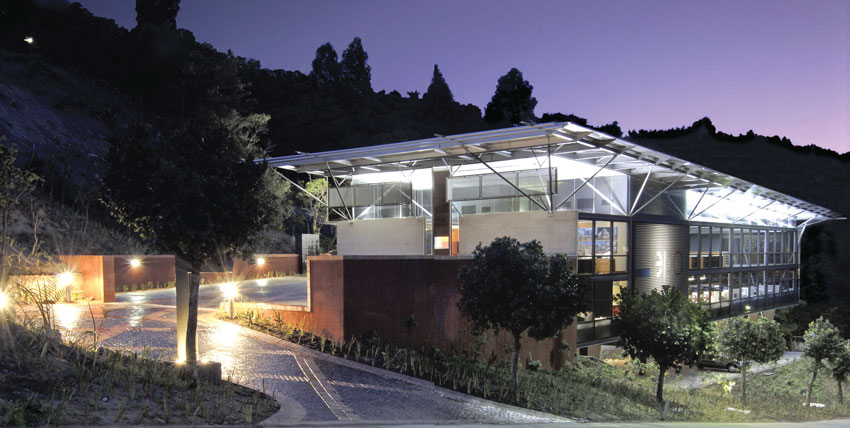
One of the finest works of glass and steel can be seen at EPA Studio in South Africa, designed by Elphick Proome Architects Inc (EPA) for their own use seeing the demand for a substantially larger and more technically sophisticated studio environment for them. Being described as a truly magnificent advert for glass and steel, the design of the studio has received several awards as Regional Institute award, SAISC National Steel award and SAIA Award of Excellence.
Located at Westway office park, Westville in South Africa, the steel and glass box of EPA Studio is crafted very carefully to its site and is comfortably fit with topography and nature. Being covered with a widely over-sailing roof, inclined in acknowledgment of the longitudinal cross-section, the building added a new name in the modern architectural vocabulary.
Site Survey & Design Philosophy
The site for the project was purchased in 2002 but the process of sub-division and environment approvals takes two and half year which resulted in to delay and hence construction on site started in late 2005. Prior to the formal sub-division of the larger site, the Studio was conceived as one of four proposed freestanding office structures positioned parallel to the contours of the steeply south-facing slope. The building footprint in the lowest portion of the site, adjacent to a wooded reserve, generated the largest floor area, which would allow the studio to operate on a single level. This position also allowed for separate street access and maximum exposure within the office park.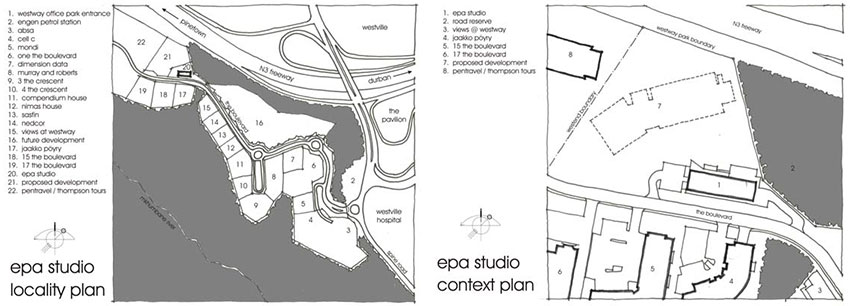
Detailed survey of the site highlighted the severity of cross-fall slopes, which would have hindered both street access and general build ability. With this information, the design was re-evaluated, which resulted in the repositioning of the building footprint at the most level portion of the site, closest and parallel to the street.
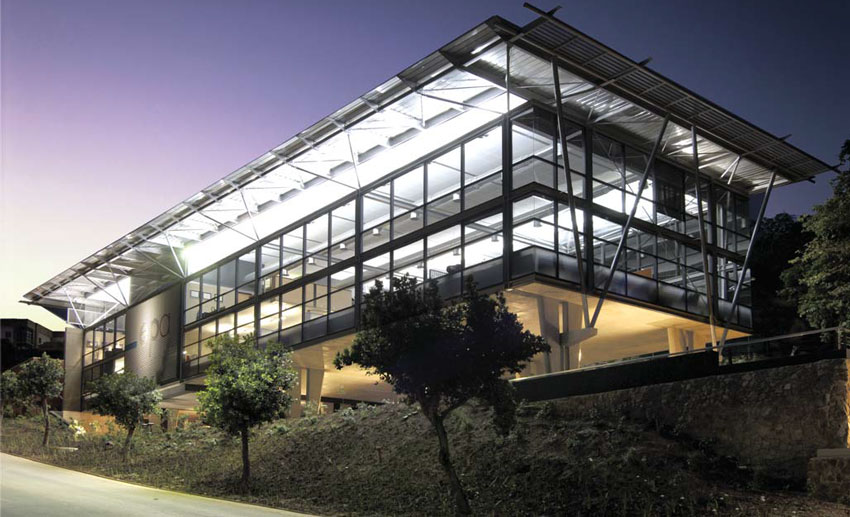
Other than the functional requirements for meeting areas and positioning of the building, a brief was collated from the staff regarding the Architectural philosophies that should generate the concept for the new Studio. Those philosophies were summarized here as a building to be set within a natural bush/indigenous landscaped environment:

- To exude a bold and simple regional quality capitalizing on distant sea views
- Raw, natural materials to display honestly and visceral integrity
- Emphasis on creating and innovative deployment of materials and components
- Low maintenance finishes in a sensitive and a practical application
- Careful use of integrated climatic control elements
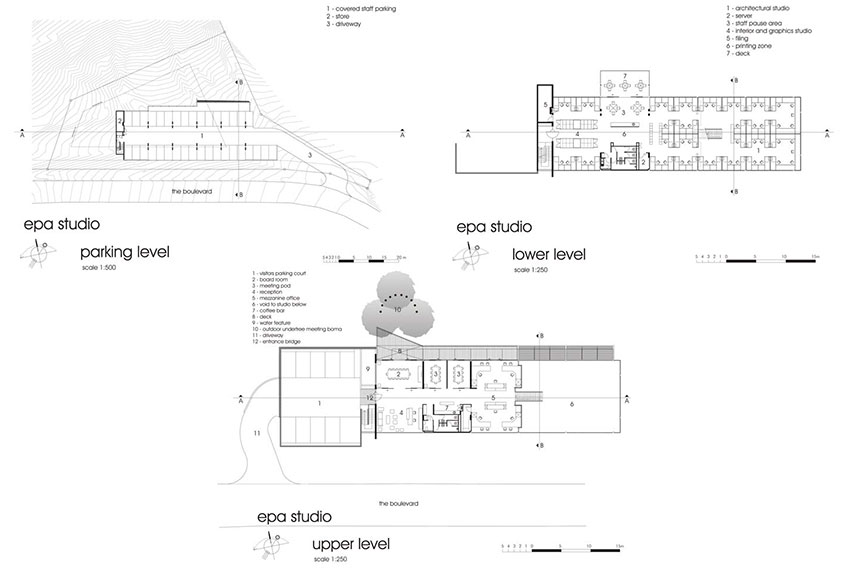
Structural Design
The EPA Architectural firm always strive to create buildings and spaces that respond to the unique nature of each project with integrity. Their design philosophy emphasizes an appropriate architecture that responds to function, context, region and climate.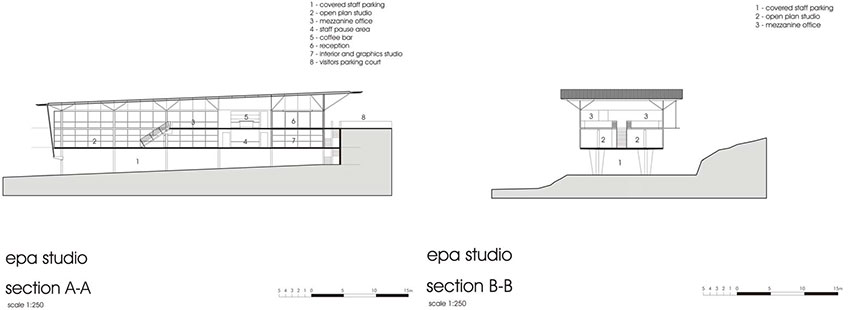
| Details | |
| Architects | : Elphick Proome Architects Inc. |
| Quantity Surveyors | : Francis Williams-Jones Kgole |
| Structural Engineers | : Young & Satharia |
| Electrical Engineers | : Ugesi Consulting |
| Mechanical Engineers | : BD&O Design Partnership |
| Landscape Architects | : Uys & White |
| Main Contractor | : Construction ID |
| Location | : South Africa |
| Structure | : Steel Structure, Curtain Warning |
| Site Area | : |
| Cost | : |
| Year of Completion | : 2006 |
The architectural design of the studio re-evaluated by EPA has been able to capitalize on distant southern views, as well as the immediate environment of natural bush and indigenous landscaping to the east and north. The building form responds to this by becoming a rectangular glazed pavilion, elevated on tapering concrete columns that vary in height according to the slope of the site.

The west end of the longitudinal arrangement engages into the hillside which allows entrance into the highest level of the building through a five meter high front door. This floor accommodates reception, meeting rooms and Director's workspaces which overlook the double volume general workspace below.

The design of the studio has generated a spatial organization allowing ease of circulation and a variety of meeting venues which has promoted communication and creative interaction between the users of the Studio. The rational layout of functions and integrated services, allows for future planning flexibility to respond to the ever adapting demands of the practice. The integration of spatial dynamics and structural expertise has created an inspirational environment for staff and visitors alike.

The parking area is located within the diminishing volume of the lowest level and surrounded by waist high walls, which draw the eye to the front wall. Water features to the left and to the front, and a wall cladded in part with concrete and in part with low-level glass, surround on either side and above. Within the garage area careful attention to materials, structure and lighting create a different but equally powerful staff arrival area. The full-height purpose-designed steel-framed wooden door covered with glass is the piece de resistance.
Materials Used
<
Structurally, the off-shutter finish concrete columns and wall elements support and brace the steel structure above. Inspired by the close relationship to the adjacent tree canopy, the roof evolved into an oversailing inclined plane supported by a steel structure of 'branch-like' brackets. Having no vertical members they allow the glass envelope to run unobstructed around the corners of the building and reach up to the oversailing roof above. The roof spans the longitudinal axis, pitching with the gradient of the adjacent street. This allows for generous internal volumes to the upper floor reception areas and creates an elevated scale appropriate to the main entrance of the studio.
The external experience of the building is enhanced by the timber-clad exposed steelwork of the external balconies, which are also surrounded by carefully detailed steel and wire balustrade. Another of those superbly detailed items, stunning in its simplicity, is the steel-supported staircase leading from the lower working areas to the upper reception areas. What makes this so special is the exquisite detail of the timber treads supported in steel pans to the staircase. A special effect has been created.
Besides its extraordinary aesthetic quality and brilliant workmanship, the studio has multi-adjustable blinds fitted to the windows that maximize natural light and eliminate glare. This is further supported by the external galvanized grating, which has been used both decoratively and as a sunscreen.
Other features relating to the outer impression is the louvred section of the wall, which hides the air conditioning plant. A neat set of letters 'epa' (for Elphick Proome & Associates) attached to the wall is the only clue as to who the occupants are.
Close teamwork, from the initiation of the project, between the architectural and the engineering and construction teams was an important factor in the successful completion of the project. This is evident in the neatness of the site-welded steel connections, the beam-to-column bolted connections, and the curved-plate pinned connections to the sloping tubular columns, which all played an important role in achieving this very special structure.
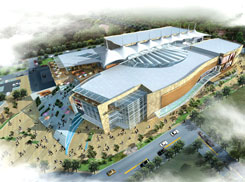
Magarpatta City Retail Mall Pune
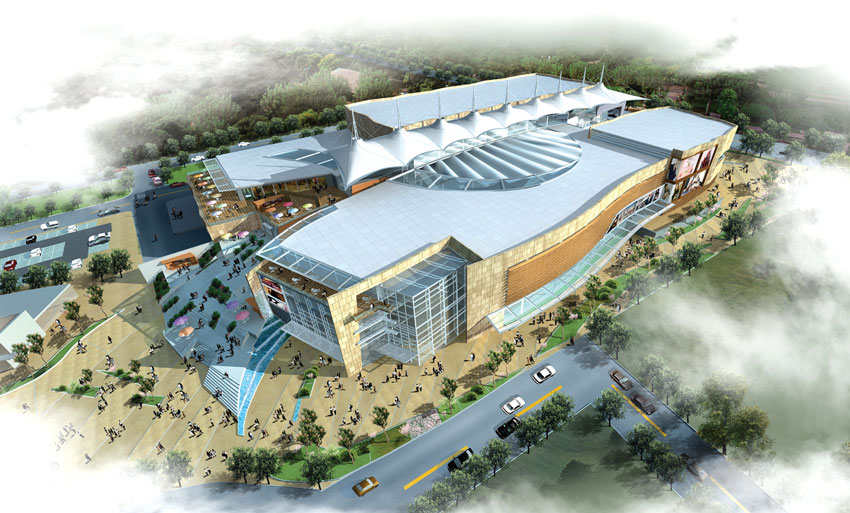
Magarpatta Township Development & Construction Co. Ltd. Approached to the architect Benoy to design their project Magarpatta City retail mall in Pune.
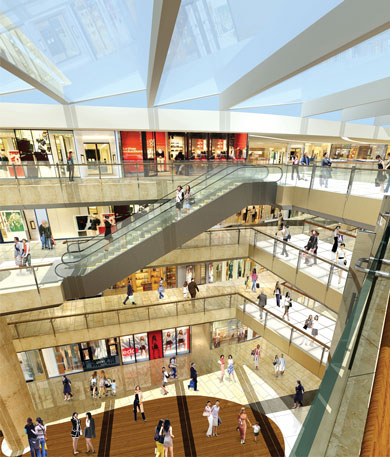
Thus, the innovative design of the first major retail offering within Magarpatta City takes into consideration the city's climate and integrates the landscaping with the building, harmonising indoor and outdoor environments at every level. Pockets of outdoor areas are inserted at various levels along the stepping landscapes to break down the generic massive retail box and also to allow visitors to enjoy the temperate climate. Together with the landscaping features merging into the mall, distinctive areas with F&B and entrances are incorporated to link the exterior and interior.
The stepping terraces introduce a stacked fenestration to bring cool air along the landscape effectively, and as a whole, they form an exciting puzzle made up of stepped greenery, waterscapes and dining terraces. To control excessive solar heat gain into the building and the landscaping areas, skylight locations have been carefully considered and a lightweight tensile roof partially spanning the landscape will encourage full use of the outdoor spaces.
Client/Owner: Magarpatta Township Development & Construction Co. Ltd.
| Design Architect | : Benoy |
| Local Architect | : Associated Space Designers Pvt. Ltd. |
| Principal Architect | : Prakash Deshmukh |
| Mechanical & Electrical Engineer | : Spectral Services Consultants Pvt. Ltd. |
| Structural Engineer | : Y S Sane Associates |
| Landscape Designer | : Ravi & Varsha Gavandi |
| Interior Designer | : Benoy Ltd |
| Other Consultant/ Project Managers | : CB Richard Ellis South Asia Private Limited. |
| Marketing Consultant | : Jones Lang Lassale Meghraj |
| Site Area | : 50,189 square metres |
| Total Retail Gross Floor Area | : 60,900 square metres |
| Building Height (metres) | : 21 |
| Building Height (storeys) | : 5 and 2 basement car parks |
| Construction Start Date | : November 2008 |
| Scheduled Completion Date | : 2010 |
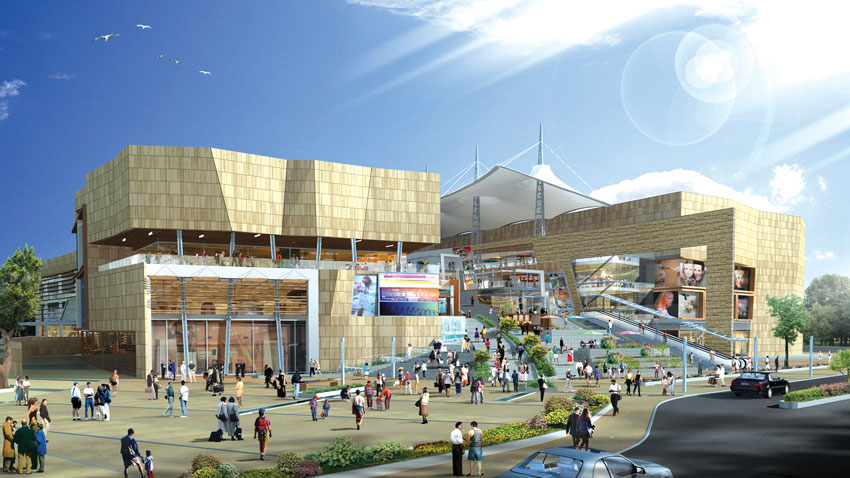
The aim of the design was to create a destination for not only the township but also the entire city of Pune. In addition to the unique spaces and a focus on outdoor amenities, this four-storey retail complex will offer a range of different sized shops, cinema, entertainment facilities, department stores and a hypermarket, with 207,000m² of leasable floor area.
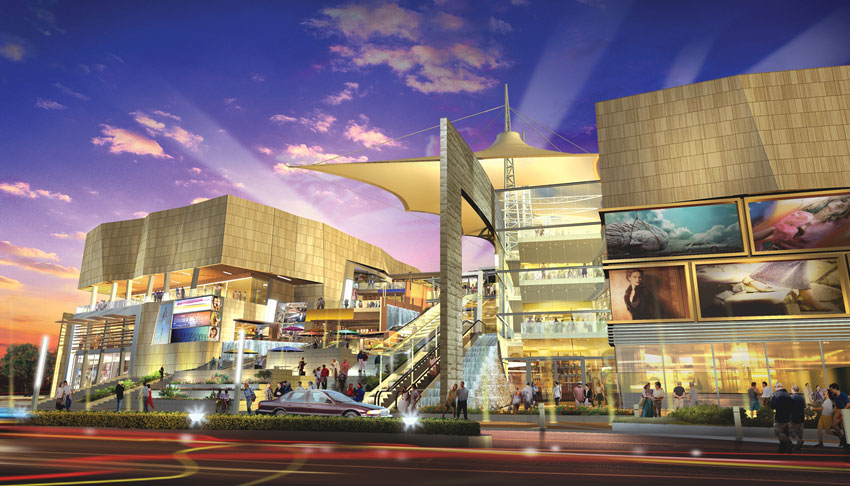

Zaha Hadid Architects Win Cairo Expo City Competition

Renowned London based architect, Zaha Hadid has been selected to design the new Cairo Expo City, together with global multi-disciplinary engineering consultancy Buro Happold.
The winning design for Cairo Expo City delivers a unique facility for Cairo––a 450,000 square metre, state-of-the-art city for exhibitions and conferences, located between the centre of Cairo and the city's airport. The project comprises a major international exhibition and conference centre with business hotel. A further office tower and a shopping centre are also proposed.
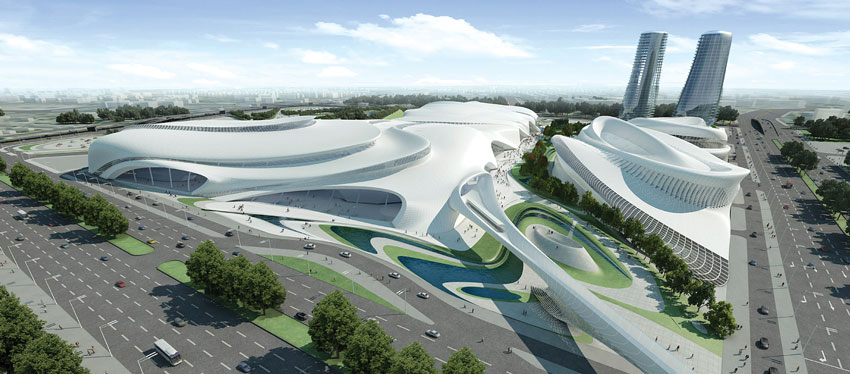
The project is one of great significance for Cairo, a city which is undergoing revitalization. "This is a truly national project for Egypt." said Sherif Salem, CEO of the GOIEF (General Organization of International Exhibitions and Fairs). "The current exhibition halls for Cairo do not meet the standards now required by the international conference and exhibition industry. With this exceptional design by Zaha Hadid Architects, Cairo will be among the world's top cities for conferences and fairs, able to cater for the widest variety and size of events."
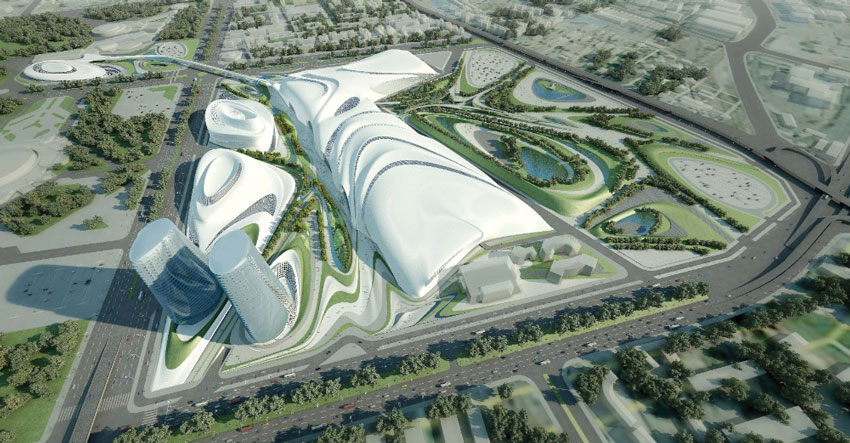
Architect Zaha Hadid explained, the undulating fluid forms of the Cairo Expo City design were inspired by the natural topography of the Nile valley. "As the exhibition spaces require the greatest degree of flexibility, we wanted to ensure that all the public spaces and formal composition of Cairo Expo City relate to the surrounding Egyptian landscape," said Hadid. "Along the great rivers of the region, most particularly the Nile, there is a powerful dynamic - a constant flow between the water and the land - which extends to incorporate the neighboring buildings and landscapes. For the Cairo Expo City design, we worked to capture that seamlessness and fluidity in an urban architectural context."
Carving and sculpting processes have been used to divide the very large exhibition and conference areas required for Cairo Expo City into clusters of individual buildings that have their own formal composition, yet each building relates to the overall design. A main north-south artery is carved through the design, with secondary streams converging at the centre to ease crowd traffic during event. The movement of people within these streams informs the building entrances on the site.

Zaha Hadid Architects was shortlisted with Norwegian architecture practice Snohetta for the second phase of the competition in April. Works will begin in October this year to clear the site.
Client: GOIEF (General Organization of International Exhibitions and Fairs), Cairo
| Design | : Zaha Hadid Architects |
| Engineering | : Buro Happold, London |
| Quantity Surveyor | : Gleeds, London |
| Traffic and Logistics | : Buro Happold, London |
| Built Area | : 450,000sqm (exhibition halls, conference center and mixed-use areas) |
| Height of Towers | : 33 and 31 stories |
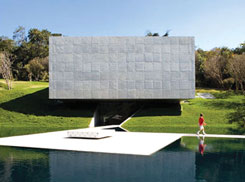
Galeria Adriana Varejão, Brazil
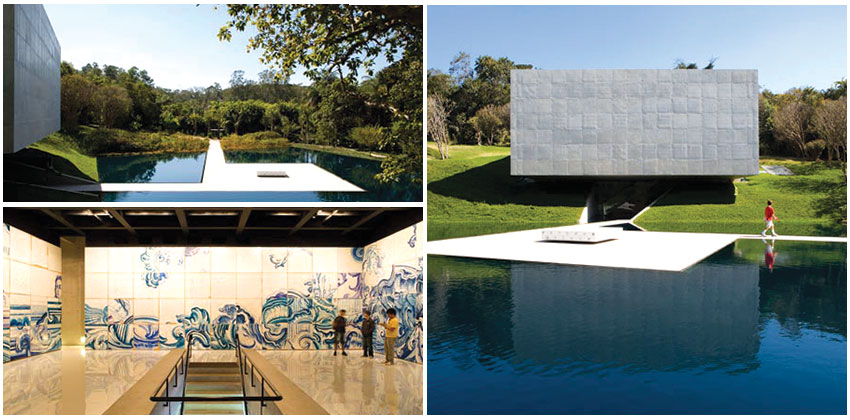
This is a "made for each other" case – a museum made up of multiple pavilions throughout the 35-hectare park designed to house a sculpture and polyptych by Brazilian artist Adriana Varejao. The Adriana Varejão Gallery was built to house two works of the artist the sculpture Linda do Rosário and the polyptych Celacanto Provoca Maremoto. The artist added four more works to the project as it developed.
Located in Brumadinho, Belo Horizonte, the capital of Minas Gerais is the Inhotim Centro de Arte Contemporânea. Inaugurated in March 2008, the museum is the personal initiative of the Bernado Paz, a mining industrialist. The entire museum is spread over several pavilions rather than a single unique building. The building, designed by the architect from São Paulo, Rodrigo Cerviño Lopes, covers an area of 477 sqm and creates a spiral path that starts in the middle of a shallow pond and then leads up to the second storey where there is a large open space. This terrace has a bridge which crosses over to an area to which Inhotim is expanding, a new lake.
Structural idea
The project occupies a hillside with a small slope that is typical topography of Minas Gerais, partially covered by the native forest. Formerly, the area was used to store containers, for which purpose the hillside was cut to create a horizontal plane. The orientation of the Galeria Adriana aimed to recompose the site's original topography and inserting the artificial element – in this case a regular block in reinforced concrete. An irregular retaining wall gains the space in the ground floor and bears the load of the block. At its deepest two beams and four columns are integrated in the wall to further spread the load.The path followed
Galeria Adriana includes a spiral path that connects two different levels of the park. The movement alternates moments of contraction depicted by the passage and expansion into the exhibition in nine phases. It goes from the ground floor in the middle of the water pond, as a narrow walkway away from the building thought the exhibitions to the terrace above the concrete block with the bridge as the final contraction.Surrounding the whole is the pool that quietly reflects light on the flat block face of the building brightening the exterior as the art works add glory to the interiors. A perfect match!

SymHomes MK–1 New Wave of Architecture in India

Constructing a steel apartment in a region where summer temperature can rise to 111Degree F is insanity, but Piercy Conner's award winning design for Indian apartment SymHomes Mk-1 makes the unthinkable solar solution sustainable, says Mariya Rasheeda.
Piercy Conner, one of a new generation of British architects create bespoke solutions by interweaving the poetic, the pragmatic and the materials to deliver distinctive and ambitious architecture. The young practice has a backlist of admired, imaginative projects where the old, high-energy, Newtonian assumptions of building geometry give way to more flexible and relativist concepts. So an award-winning Piercy Conner design for sustainable urban housing in Kolkata is especially interesting.
The Piercy Conner designs, known as SymHomes Mk1 intended to come at Rajarhat New Town in Kolkata soon as the application submitted for building sanction gets its approval. Works on it are scheduled to start in September 2009 and deadline for building completion is 2010. The buildings have a structure of elegantly proportioned steel boxes within steel boxes, manufactured elsewhere and trucked on to site. Distinctions between outside and inside are not absolute; at the same time, the perforated envelope allows air to circulate while providing adequate protection from monsoons.
SymHomes Mk1
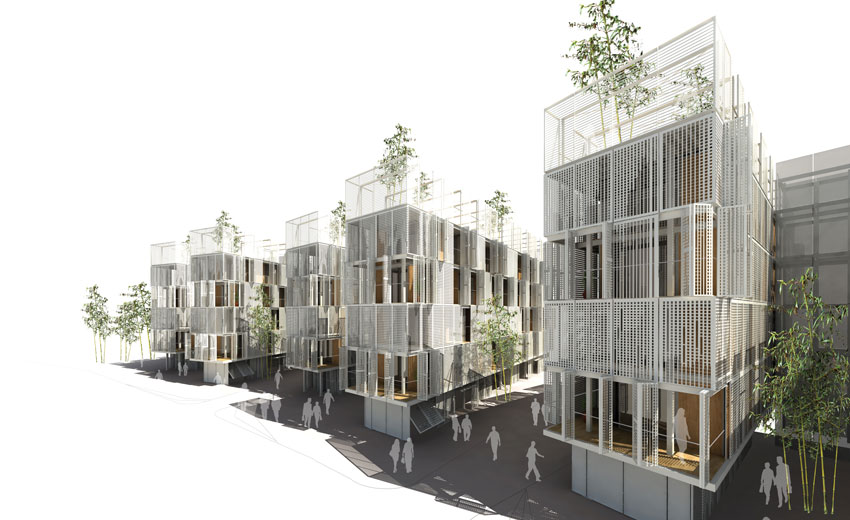
Piercy Conner's design of SymHomes Mk1 was the winning entrant of The Living Steel International Architecture competition in 2005 and went on to win the MIPIM AR Future Project Sustainability Award in 2007 for its imaginative and sustainable use of steel.
A steel box-within-a-box might not sound feasible in the hot Indian sun, but this innovative design boldly goes where no steel has gone before: not only does it succeed in fulfilling the brief to develop the use of steel in residential building but it also offers an imaginative and simple alternative to air conditioning units.
The outer perforated panels help cool the building with shade and airflow and also provide a rain screen during torrential rains. This environmental buffer zone, symbiotically linking the inner and outer spaces, conditions the climate naturally, minimizing the use of electric air-conditioning units. When needed, an inner skin can be sealed to allow air-conditioning units to be used in extremes of temperature.
Stuart Piercy, the director on the project, drew on vernacular architecture for inspiration. "Western architecture is dominated by the sealed environment whereas architecture in India is much more open and expressive," explains Piercy. "We wanted to create something that draws on the permeability of subtropical architecture which historically uses shade, sun-paths and wind channeling to control environmental factors with minimal impact on the planet."

Inspiration also came from a development in the motor industry. At the time Toyota and Lexus were developing the Hybrid Drive Engine, a dual engine which offers an electric motor to minimize the role of the fuel-guzzling petrol engine. Similarly, the responsive double skin of SymHomes Mk1 means air conditioning units are only used in extreme conditions, thereby creating a highly sustainable environmental system for the project.
On a visual level, SymHomes Mk1 embraces both the demands of modern expansion and the cultural heritage of Kolkata, also known as the City of Palaces. The deep shaded terraces surrounding each apartment echo the arches and courtyards of the Mughal, Gothic, Baroque architecture of India's indo-islamic history, creating an aesthetic intrinsically linked to context and culture. The perforated steel of the shutters creates a filigreed pattern, reminiscent of the intricate stone work and metal work found in India's traditional buildings. "India is on the verge of a building explosion but we wanted to avoid the anonymity of Dubai-style development," says Piercy. "Instead we wanted to offer a culturally sympathetic yet environmentally intelligent building which retained an Indian identity and created a role-model for sustainable living."
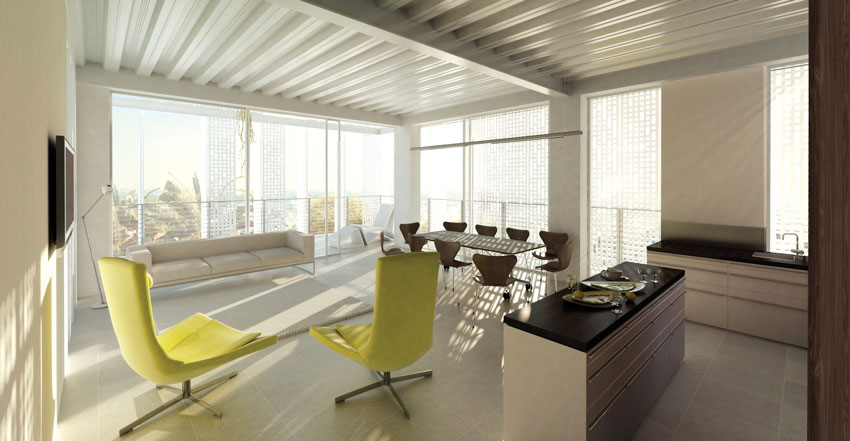
On a practical level, the steel allows the delivery of SymHomes Mk1 to be based on a ‘kit of parts' principle with each component being readily available through discussion and development with supply chain partners TATA Bluescope, whose steel factories are based in India. This increases the speed and accuracy of construction, reducing financing costs and allowing earlier occupancy. The dye for each panel can be kept to fabricate replacement panels with minimum financial and time impact.

The Government of West Bengal, along with high profile private and public sector companies, is working on providing the township with the latest infrastructure and amenities to make it one of India's major industrial and technological hubs – a second ‘silicon valley' after Bangalore.
Targeted to young professinoal families, SymHomes Mk1 offers high-end specifications.
The development comprises six three-bedroom apartments (101m2 plus terraces) and six four-bedroom apartments (143m2 plus terraces), affording spacious and luxurious living for twelve families.

Joint clients Living Steel and Benhal Shrachi (local developers) are delivering the project in India offering valuable local and international knowledge. Works on site are being overseen by Kolkatan architects Sanon Sen.
This development is not only India's first sustainable steel residential building but also demonstrates how sustainable architecture can deliver inspirational design without compromise. SymHomes Mk1 sets the bar for India's New Wave of architecture.
Client: Living Steel
| Novated | : Bengal Shrachi Housing Development |
| Location | : Kolkata, India |
| Size | : 35,000 ft2 |
| Value | : £2,000,000 |
| Start | : September 2009 |
| Complete | : 2010 |
| Involvement | : Executive Architect |
| Team | : Richard Conner, Partner Nick Francis, Associate Architect Matti Lampila, Architectural Assistants |
| Structure | : Adams Kara Taylor |
| M&E | : Faber Maunsell |
| QS | Jackson Coles |
| Suppliers | Tata Steel |
| Awards | MIPIM Sustainability Award, Winner MIPIM Residential Award, Finalist EMVS Sustainability Awards, 2nd Place |
SymHomes Mk2
Recently, Piercy Conner launches second phase of steel home design. Hot on the heels of the award-winning Symhomes Mk1 comes Symhomes Mk2. Following Piercy Conner's work for the Living Steel steel housing programme in Kolkata, India, Symhomes Mk2 is a logical advancement in design. This high rise speculative building for mixed commercial and residential use takes the double-skin concept to the next level. The stacked, arched structure - a reference to the playful and expressive nature of Hindu temple architecture - facilitates a 360 degree open balcony offering unimpeded views from all aspects of the building.
Living Steel is championing the cause for steel construction. Basing their campaign on the projected figures from the United Nations that the population will explode by as many as two billion people over the next 25 years and a general migration pattern from rural to urban centres, they claim that steel is the material that allow architects to keep up with the pace of demands allowing for buildings which can be rapidly constructed, also heralding its recyclability.

Swimming Pools The New Lifestyle Statement

Swimming Pools are often found as part of a larger leisure centre or recreational complex which takes you to an absolute different and serene world. Today's hard and fast life makes the people tired and irritating. They look forward for some measures which provide relaxation and peace of mind to them in a short period of time. And Swimming pool, is a solution for the same.
Pools may be both public and private i.e used for personal as well as for commercial purposes. Pools that may be used by many people or by the general public are called public, while pools used exclusively by a few people or in a home are called private. Many health clubs, fitness centers and private clubs have public pools used mostly for exercise. Hot tubs and spas are pools with hot water, used for relaxation or therapy, and are common in homes, hotels, clubs and massage parlors.
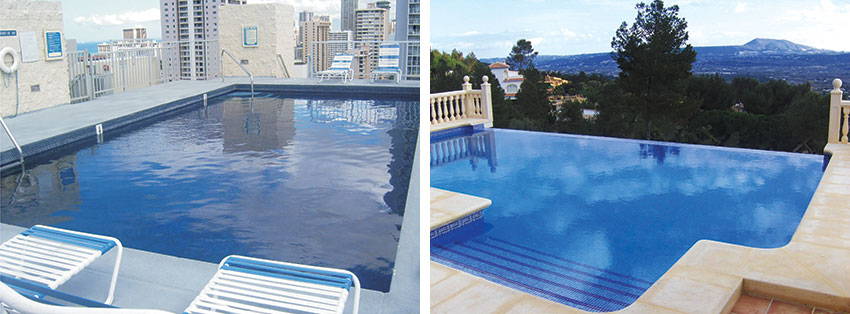
A pool is an artificially enclosed body of water intended for swimming or water-based recreation. It can be built either above or in the ground, and from materials such as metal, plastic, fiberglass or concrete. Ferrocement has been extensively used for making domestic swimming pools in the past there decade Having a swimming pool is certainly a lifestyle statement. Any piece of luxury real estate worth it’s salt will probably have a swimming pool on the property. With the demand for swimming pools on the rise, today swimming pools come in all sizes and prices - each to accommodate the taste, style, size, and budget of their buyers. They come in various size and shape depending on the availability of property.
Technology Pools- a single solution provider
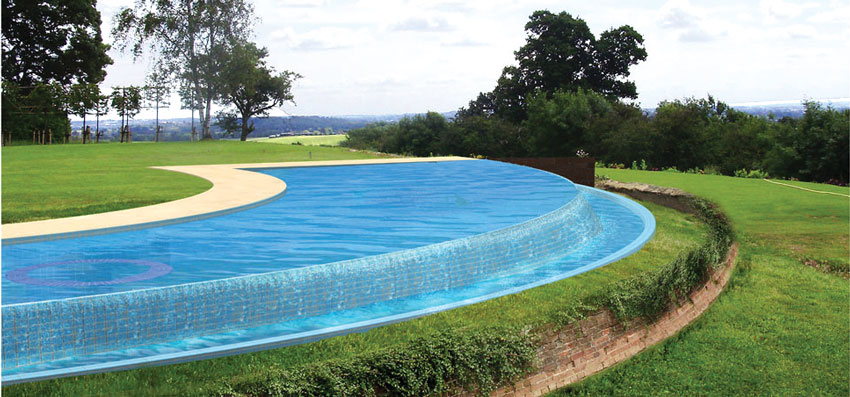
One of the most and difficult aspects of swimming pool building process is the selection of a specialist builder. It is always advisable to go in for a specialist, who has the right intention to provide the best of the products and advice. Apart from selection, designing is another very important aspect that can either add to the beauty of the surrounding or spoil the beauty of it.
Here is a single solution provider to all your problems. Technology Pools, one of the leading luxury swimming pool design, consultancy and installation companies offers different types of pools—Outdoor Pools, Indoor Pools, Private Pools, Hydro Pools, Resort Pools, Water Parks, Society Pools etc—and the design for all these options are also quite different in nature. With over 25 years of cumulative experience and after immense success in U.K they are now in India. It offers you the renowned professionals and the best of workers that help in designing the pool as well as guiding you on minute details like—materials to be used, size and shape, maintenance, swimming pool safety, etc.

In India, the company provides latest pool filtration equipment from all over the world, extremely reliable advice and accurate technical specifications with effective project management. Its esteemed clientele include rich businessmen, five star hotels and international schools. Technology Pools also offers customized economic solutions for budget conscious buyers, and have been favored suppliers for a number of building society pools for that reason. It aspires to provide the best possible pool construction techniques for best water quality whilst maintaining comfortable and safe conditions. Apart from swimming pools, the company is also into the building of Spas, Jacuzzi, hot tubs and sauna and has already completed a number of projects in India as well as abroad.
Ultra-level Infinity Pools-a design marvel
Technology Pools has launched Ultra-level Infinity Swimming Pool, a concept coined by the company's CTO, Hemant Atrish in India. These pools are considered to be the most stunning pools and enhance customers' home and environment with a touch of luxury and elegance.Ultra Level Infinity swimming pools are lively and by swimming in an ultra-level swimming pool one enjoys the healthy resort lifestyle at home. These swimming pools have no edges or walls and the edge of the water blends into the horizon. These blue fresh Ultra level swimming pools are eye catching and beautiful. "Ultra Level Infinity pools come in a variety of shapes and sizes. Apart from the standard sizes, they can be further customized to meet the exact specifications. Whether the customer wants to extend the length of the pool, add radius corners, or create a unique shape, Technology Pools has the expertise to crate a pool that suits the exact requirement of the customer," commented Hemant Atrish, CTO, and Technology Pools.
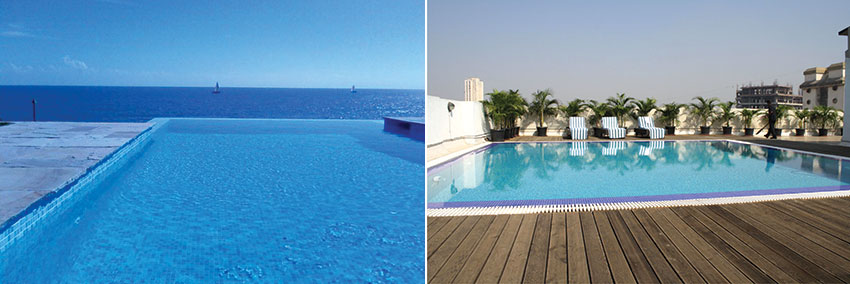
These stunning beauties create the illusion of water reaching past the edge of the pool edge and meeting the horizon. But it's really not. Ultra level infinity pool is a design marvel. These pools have usually a minuscule basin surrounding the perimeter, which catches the water when it falls over the side. From there the water is pumped through a secondary filtration system which brings it back into the pool. And, because usually they are built on cliffs and hills, the effect of the water going over into nowhere is quite entrancing.
With infinity pools one also has the option to choose the most striking materials and exotic designs that exist. There is also the option of including relaxing spas and other luxuries. These swimming pools have already captivating residential customers across the globe and the company is looking at repeating the same success in India as well.
Roof Top Swimming Pools
The company has recently started the services of Roof Top Swimming pool in India. Rooftop swimming pools offer some of the most spectacular design opportunities but at the same time some of the greatest challenges also. And here Technology Pools Rooftop swimming pools will meet these challenges with state-of-the-art pools that are lighter in weight than conventional construction and faster to install.
There is a lot of creative and technical designing for the structural engineers and pool designers to come up with detailed top roof pool plans. To handle the weight of the water, the pool sits atop the building's structural concrete columns. The pool shell is made watertight by elaborate waterproofing methods to prevent leakages associated with inferiorly designed pools that can prove extremely costly to repair. Its decking is supported by a steel frame and lightweight concrete.
Technology Pools has the expertise and capability to design an ultra level infinity swimming pool for almost any location, one does not necessarily need to have a sea view property. Even a sloping garden would do just fine. The company's attitude, education, training, experience and vision to help in making the customers' aspiration come true by developing a swimming pool design that maximizes the returns on the money spent and simplifies the entire swimming pool construction process.
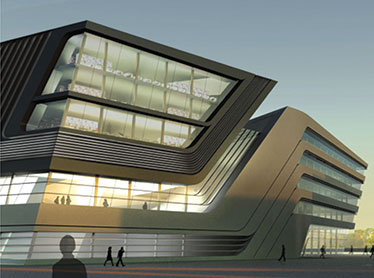
New Library & Learning Centre in Vienna
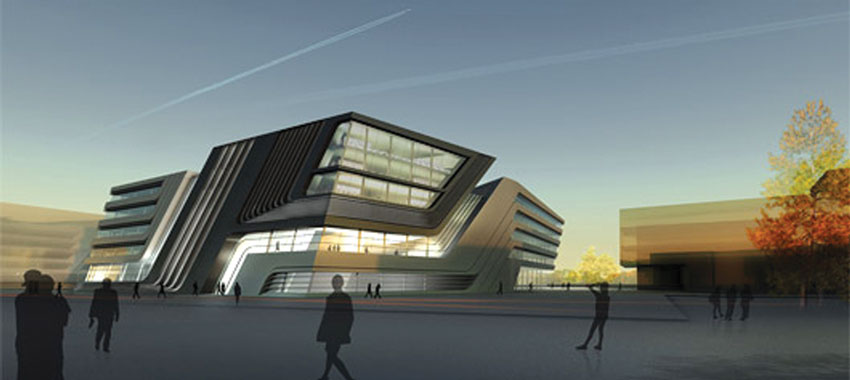
The University of Economics & Business, Vienna will soon have a new Library and Learning Centre that will be the centerpiece of the University's new campus and provide a significant upgrade to the University's services. Designed by a famous architect Zaha Hadid, the design is described as a 'Polygonal Block' with both inclined and straight edges.
Structural Design
Zaha Hadid has been selected as the architects of a library and learning centre (LLC) for the University of Economics & Business in Vienna. Hadid beat Pritzker Prize winner Thom Mayne's US practice Morphosis and Italian architect Massimiliano Fuksas during a competition to win first place, which was judged by a jury headed by Austrian architect Wolf Prix.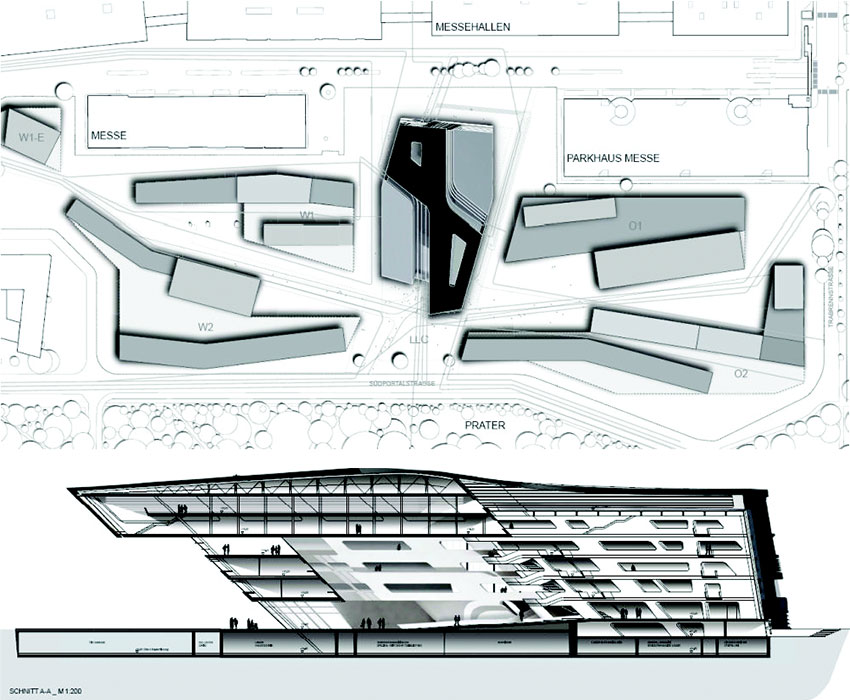
According to Zaha's design the new Library and Learning Centre rises as a polygonal block from the centre of the new university campus. The LLC's design takes the form of a cube with both inclined and straight edges. The straight lines of the building's exterior separate as they move inward, becoming curvilinear and fluid, generating a free-formed interior 'canyon" that serves as the central public plaza.
All the other facilities of the LLC are housed within a single volume that also divides, becoming two separate ribbons that wind around each other to enclose the glazed gathering or central space.

'I am delighted to be working in Vienna as I have a close affiliation with the city. As a centre of research, the Library and Learning Centre is forum for the exchange of ideas. It is very exciting for us to be part of the University's expansion,.' states Zaha Hadid.
Covering an area of 42,000 sq m, the winning design is 136m long, 76m wide and 30m high, five storey building that will house learning centre as well as training rooms, administration offices, a library, clubroom, auditorium, book shop and ancillary services areas.

Rector of the University of Economics & Business, Christoph Badelt said "A library and learning center should be more than a mere library in the classical sense: it is a research and a service facility, a workplace and lounge, a place of communication and a traffic hub, at one and the same time. With its breathtaking architecture, the design byZaha Hadid manages to combine all the key functions of study in a most wonderful way. It is a vision that embodies this innovative concept of a university."
Program
The LLC comprises a "Learning Center" with workplaces, lounges and cloakrooms, library, a language laboratory, training classrooms, administration ofûces, study services and central supporting services, copy shop, book shop, data center, cafeteria, event area, club room and auditorium."Arup's Berlin office will be responsible for engineering the building and the project architect is Cornelius Schlotthauer. The project is expected to be completed by the end of 2012.
| Architect | |
| Design | : Zaha Hadid with Patrik Schumacher |
| Project Architect | : Cornelius Schlotthauer |
| Project Team | : Marc Philipp Nieberg, Kristoph Nowak, Enrico Kleinke, Stefan Rinnebach, Niels Kespohl, Jan Hübener, Romy Heiland, Richard Baumgartner |
| Consultants | |
| Structural Engineers | : Arup Berlin |
| M&E Engineers | : Arup Berlin |
| Façade Engineers | : Marc Philipp Nieberg, Kristoph Nowak, Enrico Kleinke, Stefan Rinnebach, Niels Kespohl, Jan Hübener, Romy Heiland, Richard Baumgartner |
| Fire protection | : HHP West, Bielefeld |
| Render Studio | : Vectorvision, Leipzig. |

The Blue Planet: Denmark's Most Modern National Aquarium
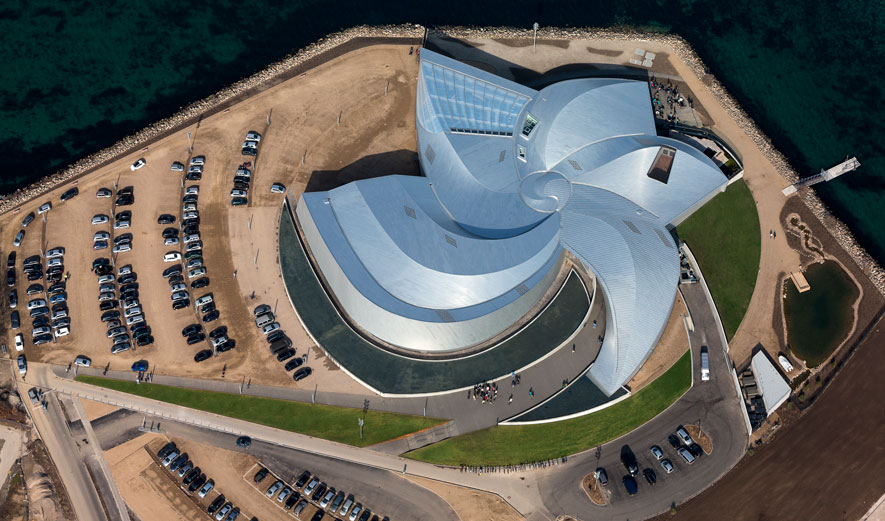
North Europe recently gets its largest and most significant whirlpool-shaped aquarium 'The Blue Planet' in Denmark which is expected to become an internationally acknowledged destination attracting guests from all over the world.
Located on the shores of Øresund, only eight kilometres from the Copenhagen City Hall Square, The Blue Planet is a building of high complexity with a welcoming and fascinating framework for the guests' encounter with both animals and nature while it houses a well-adapted ecosystem suited for some of the world's most sensitive animal species.
Being inspired by whirlpool and with its location next to Øresund, the aquarium brings land and sea together and pulls both nature and visitors down into the depths. It is equipped with the latest advanced AV technology to create a complete experience which pulls the visitors into an atmospheric underwater universe that can fascinate and seduce both adults and children alike. The swirl shape creates different sections and is a practical answer to the desire to expand the aquarium as one can expand in the swirl shaped arms.
The Blue Planet is Northern Europe's largest aquarium with room for over 20,000 fish and marine animals. The circular foyer is the starting point for the tour around the aquarium. From here one can select which river, lake or ocean to explore. He/she can get close to the animals both below and above water in the humid and hot rainforest. In addition, they can visit the Faroese bird cliff and meet colorful puffins and Nordic icy sharks. In the ocean, tank one can see a bunch of hammerhead sharks and elegant rays.
| At a Glance | |
| Project | : The Blue Planet, Kastrup, DK |
| Prizes | : The prize 'In-Situ Prisen 2013' awarded by the Danish concrete association, Dansk Beton. |
| Client | : The Blue Planet Building Foundation (Realdania, Knud Højgaards Fond, Tårnby Kommune) |
| Function | : Aquarium |
| Gross Floor Area | : 9,700 m2 |
| Completed | : 2013 |
| Architect | : 3XN Role |
| Engineering | : Moe & Brødsgaard |
| Exhibition Design | : Kvorning Kommunikation og Design |
| Landscape Architect | : Henrik Jørgensen LANDSKAB |
| Picture Courtesy | : Adam M¢rk |

The whirlpool
Inspired by the shape of water in endless motion, Denmark's new National Aquarium, located on an elevated headland towards the sea, north of Kastrup harbor, is shaped as a great whirlpool, and the building itself tells the story of what awaits inside.Its distinctive shape is clearly visible for travelers arriving by plane at the nearby Copenhagen Airport. The facade is covered with small diamond-shaped aluminum plates, known as shingles, which adapts to the building's organic form. Just as water aluminium reflects the colors and light of the sky and thus the buildings expression varies with the changes in its natural surroundings.
Out of the World Experience
Visitors reach the entrance by following the first and longest of the whirlpool's whirls. With a smooth transition, the landscape surpasses for the building, while the outdoor ponds mark the unique experience that awaits the aquarium visitors as they enter The Blue Planet: the whirlpool has pulled them into another world - a world beneath the surface of the sea.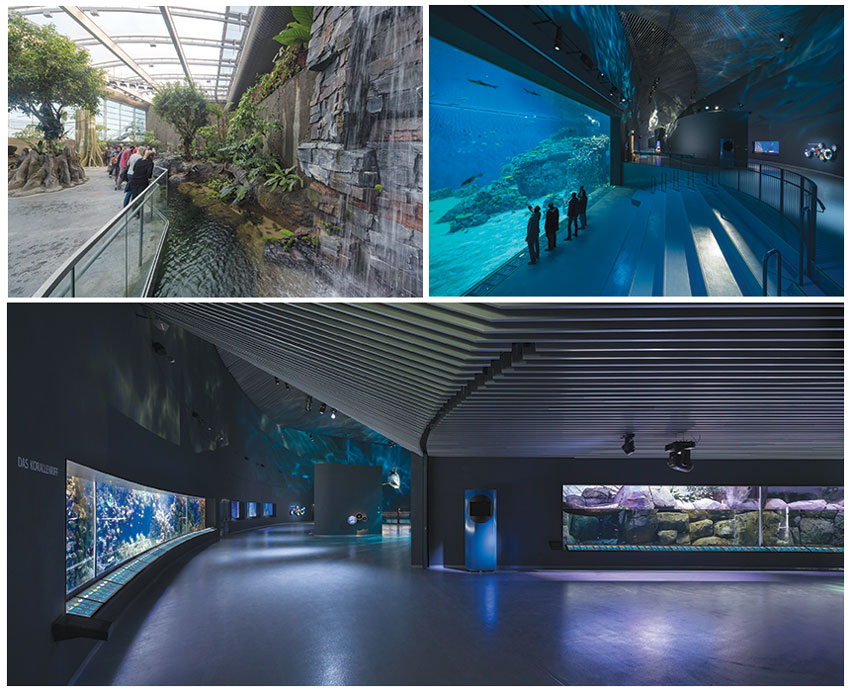
According to Kim Herforth Nielsen, Creative Director, 3XN and architect of the building,"Our wish was to bring our visitors all the way down to the world of the fish. Therefore, the design of The Blue Planet is based on the story about water and life under the sea. We visualise the construction as a whirlpool which draws visitors into the depths to the fascinating experiences waiting among fish and sea animals from all over the world."
Flexible Movement Between Exhibitions
The circular foyer is the central point of navigation in the aquarium. Here visitors choose which river, lake or ocean to explore. By enabling multiple routes the risk of queues in front of individual aquariums is reduced. Each exhibition has its own theme and entrance from the foyer, where sound and images are used to introduce the atmosphere of the different exhibition areas. The restaurant enjoys a magnificent view of the sea, which begins just a few meters away.Chairman of Denmark's Aquarium, Professor Flemming Frandsen, is looking forward to The Blue Planet as a centre for new experiences in the Øresund region. He stated, "Our ambition is to welcome 700,000 guests each year, thus being one of Denmark's five largest tourist attractions. Now, we have an aquarium, which compares to the world elite of aquariums and that brings us close to the biology of the sea and strengthens our interest in natural science".
During a tourism conference "A New Way to Grow" 2012, the Blue Planet was chosen as Denmark's best lighthouse project within experience economy, because of its potential for growth, influence on regional development, innovation, realization as well as its uniqueness and 'reason to go'.
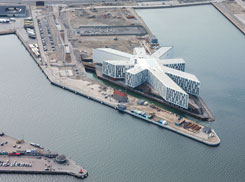
3XN’s Wonders. . .
Eight Pointed Star-Shaped UN City, Copenhagen

3XN, founded as Nielsen, Nielsen and Nielsen in Aarhus in 1986 by the architects Kim Herforth Nielsen, Lars Frank Nielsen (partner until 2002) and Hans Peter Svendler Nielsen (partner until 1992), the studio, today, is famous for two things--their preference for social and humane architecture, and projects demanding a high level of detail and employing workmanship of the highest quality.
The studio emphasizes on curiosity, originality and poetry and creates architecture for people through a complex approach tailored to users and clients. They translates visions into reality and is continually committed to making today's work tomorrow's architectural heritage.
Based on their this design philosophy, the Studio designed many prestigious projects including its latest projects 'The new regional head office of the United Nations in Copenhagen' and The Blue Planet in Denmark that have won many accolades and recognition worldwide.

UN City has been designed with clear references to the UN's identity and values. It is a building that physically reaches out to all parts of the world, while the sculptural staircase in its core reflects the UN's work to create global dialogue. Being completed and delivered in two phases: Phase 1 in 2012 and phase 2 in 2013, the project was officially inaugurated on July 4 2013 with the participation of the General Secretary of the UN.
Bringing together the various agencies and functions of the United Nations regional offices in Copenhagen, the new UN City is located at Marmormolen (The Marble Pier) north of Copenhagen's city center. 3XN's design is a response to the UN's wishes for an iconic building expressing the organization's values and authority. More specifically, the design reflects the independent, efficient and professional nature of each UN unit, while at the same time clearly rooted in a mutual set of values - Delivering as One.
High security and accessibility standards have been central considerations in the design of the new main office building. The UN City must live up to the most stringent requirements, providing a protected and safe environment, while at the same time appearing open and accommodating to the city.
Located on an artificial island, the building is naturally separated from its immediate surroundings, while still being highly visible from both the city and the water.
The Star
From above, the eight-pointed star shape is a clear visual reference point, which, like the UN, reaches out to all corners of the world. Similar to the surrounding rusty pier edges, the UN city has a dark burnished steel base from which the white main building rises. This is a reference to the elegant white ships that characterize this part of the Copenhagen harbor.
The building has a façade cladding of white perforated aluminum shutters, developed by 3XN and contractor Pihl specifically for the UN City. The shutters ensure solar shading without blocking the view or the daylight. Since the facade is divided into three meter long modules, it is possible for the employees to control the sunshade from their computers. The result is an improved indoor environment, and a dynamic façade expressing a building full of life.

From the atrium a central staircase binds all levels together. 3XN has created the staircase as a dramatic spatial sculpture, which is to be seen as a symbol of the UN's work to create dialogue, interaction and positive encounters between people in all parts of the world. In the daily life, the sculptural form inspires the UN employees to use the stairs, and thus the staircase also forms the basis for dialogue, cooperation and informal meetings between the various UN organizations.
The main office building has more than 90 meeting rooms including a number of flexible rooms on each floor that staff can use for various purposes. The auditorium is a conference facility with a total capacity of 450 people. For smaller conferences and meetings, the auditorium can be divided into smaller rooms by using specially designed partitions.
Sustainability
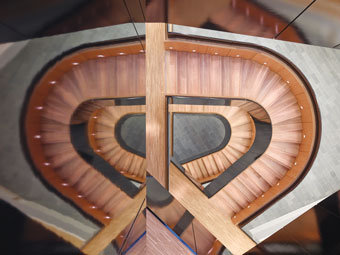
Air quality - The building has been designed to limit the use of chemicals and pollutants during both its construction and its use. The building is entirely ventilated with filtered outside air. This ensures that only clean, fresh air is present in the building and helps balance the interior humidity level.
Solar panels - more than 1,400 solar panels are lining the roof of the building to support the goal of generating renewable energy onsite. With an estimated total production of 297,000 kWh/year, the solar panels significantly reduce the need for electricity from the grid.
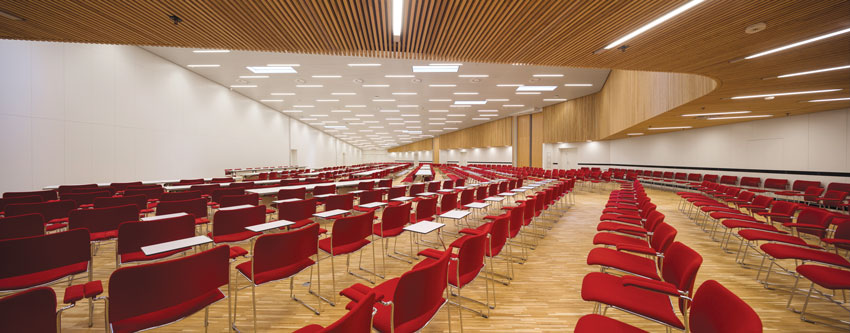
| At a Glance | |
| Project | : UN City, Copenhagen |
| Client | : FN Byen p.s. (Copenhagen Port & City Development) |
| Architect | : 3XN |
| Engineer | : Orbicon a/s |
| Landscape | : Schønherr |
| Contractor | : Pihl A/S |
| Interior Design | : PLH / UN Common Services |
| Size | : 45,000 m2 office and public facilities + 7,000 m2 archives and secondary facilities |
| Capacity | : 1700 employees |
| Budget | : Approx. 134 mio. EURO |
| Picture Courtesy | : Adam M¢rk |
Sea water cooling - Cold seawater pumped into the building's cooling system, almost entirely eliminating the need for electricity to power the cooling cycle.
Water efficiency - Innovative aerators have been placed in the taps in kitchens, toilets and showers throughout the building. The low-flow taps reduce water usage. In addition, pipes on the roof capture almost 3,000,000 litres of rainwater annually, which is almost enough to flush the toilets of the entire building without using potable water.
Solar shades - Sophisticated solar shades on the building's facade can be opened and closed to either trap or reflect the sun's heat.

Reflective roofs - The roof of the building has been coated with a white, recyclable membrane, made from plant-based materials. The environment–friendly coating reflects sunlight and reduces the solar warming of the building.
The UN City is expected to become one of Denmark's most energy efficient buildings with an annual energy consumption of less than 50 KwH per m2 (Danish Energy Class 1). The UN City is registered with the LEED sustainability ratings system with the certification goal of LEED® Platinum. UN City has been awarded the prestigious Green Building Award 2012 by the European Commission.

Swimming Pools Are Here to Stay, but at What Cost?

We do understand the aspirations of those who have enough disposable incomes to demand such super luxurious supersized designer apartments. We also are aware of the new demand created by those who would want to reconstruct their old-style villa to match the latest lifestyle trend.
What we don't understand is the lack of awareness amongst these people about a sustainable living. One should be conscious of certain facts like how a badly constructed house that consumes more than the required amount of electricity and the water guzzling swimming pools inside them can cause great imbalance to the natural resources of the already crowded urban areas.

Talking about the most important component of life; water, is already an area of contention amongst many Indian states. While the government is trying its best to regulate usage, we all must understand that water is too precious to be wasted.
While we tap water for leisure, we should know that a badly constructed swimming pool can prove too expensive for the environment as well as for you, as a consumer. Each one of us needs to be better aware to demand quality.
The Indian Plumbing Association, in collaboration with the US-based International Association of Plumbing and Mechanical Officials (IAPMO), has drawn up a code for swimming pools in India.
One such code was the need of the hour as the National Building code never had any norms for swimming pools at present. In March 2011, the ‘Uniform Swimming Pool Code – India' was documented. The code provides information on materials to be used, water heating, vents, chlorinators and the piping standards that ought to be followed.
While the manufacturers and construction organizations shall refer to this code, we as consumers should also make sure we do not compromise on quality and standards.
They still don't issue licenses to practice swimming pool construction in India. There are many players crowding the market who commit to projects without knowing the scope of what they are undertaking. Then in order to quote less to bag the project, they mindlessly compromise on quality. The worst part is, they keep the consumer in the dark and by the time your pool is up and working, your costs go up by almost 50%.
For instance, if there are constant problems with filtration, then though the maintenance charges would take care of it, the fact remains that the quality was compromised right at the outset. But, the customer had incurred all the cost for it.
Environmentally, a malfunctioning filtration system proves disastrous. Where the plumbing and filtration cannot efficiently handle the cleaning of pool water, one is stuck with water that is always riddled with dirt and potential disease causing germs. Now cleaning this, would consume high amounts of electricity as the pump for the filter is required to run for a longer duration.
One may decide to sanitize the pool, ending up dumping too many chemicals into the water. This will bring in its own set of problems, and at last you would have no option but to change the pool water. This is what makes you deplete the ground water levels in your area, for your leisure.
The repercussions of not having chosen the right pool builder, is not just limited to frequent draining out of pool water, of late this has resulted into much fatal consequences. Most of us are aware of a recent accident where a gentleman lost his life to electrocution in the pool.
Use of energy efficient lighting is also important. Hardly any one of us is aware of the fact that in an ideal situation there shouldn't be any electrical device operating at more than 12 volts in the entire pool surrounding area. One can ensure safety by adhering to quality standards.
Let's not blame the pool owners alone. We need to be better aware to demand the best quality and ensure that our lifestyle in urban India is not becoming a threat to the other half.
Premium Pool's innovative approach towards sustainability
Be assured that achieving sustainability doesn't mean loss of luxury. It's all about creating a demand for sustainable homes of which innumerable benefits accrue by the way of reduction in water and electricity bills.With pools, a simple way to ensure happiness is by taking care of durability, comfort and long-term cost benefits. This can only be done by choosing the right builder at the onset.
We at Premium Pools are confident of being an unrivalled pool design and construction company that has helped several green buildings achieve better energy and water efficiency.
World over, this industry is operating within stipulated guidelines and following strict standards with respect to safety and quality. In India, surprisingly, what gets the least attention is safety itself.
With our commitment to make any and every swimming pool safe and clean, we decided to partner with international experts.
Having the distinction of collaborating with America's No. 1 pool builder – Premier Pools and Spas in addition to a tie-up with Europe's largest swimming pool builder, Albixon, for the state-of the art equipment, we have always been inspired to deliver projects that have distinguished themselves in numerous ways.
We are also confident of a great team on board that has to its credit, hands-on experience with some of the prestigious projects internationally, making it easier for us to stick to our commitment to quality.
Working close to such standards, every year, we have turned down projects looking on to the psyche of Indian customers and people involved with a swimming pool. Sadly, the mindset remains restricted to treating a pool as a commodity. In fact, we can go on to the extent of saying that it's better not to have a pool than end up having something which is a great financial as well as environmental burden.
This industry remains unregulated with no entry barrier and it is upon us to help streamline things to help the industry gain a proportionate capital share to help every business concern sustain itself to offer the best of swimming pools that are a good investment in every respect.
Currently, the industry can't look within to compete as there is lack of expertise and hardly would you find someone living upto the claims of making a good pool.
In fact, a great way to help the industry see new heights is by coming at par with other industries where people are tapping luxury in every way looking on to the kind of incomes at their disposal.
Unique Projects Undertaken
Aahana Resort
Jim Corbett National Park situated at Nainital district Uttrakhand is one of the oldest Tiger Reserves known for the preservation of the endangered Bengal tiger enjoys unique geographical features that have made it one of the most sought after tourist destinations in Asia. It is just a 4 hour drive from Delhi NCR. Tourists apart from exploring the beauty of the jungle through nature walks, jeep or elephant safari also enjoy the world class human innovation i.e. the resorts.
While you have almost all the resorts along the river, Ahana – The Corbett Wilderness broke the conventional tradition as it touches the forest of Corbett all along its entire length on the north-eastern boundary. The founder of the property Mr. Kamal Tripathi while creating his resort had in mind to make it a spa destination incorporating in it all the five elements of nature i.e air, water, sky, fire and earth, and hence ensuring it to be at par with any world class spa destination. Therefore, the challenge before Premium Pools was to design the entire Landscape in a way that the pool completely blended with the forest in the backdrop, giving an impression like it always existed there and is not a man-made structure.
With the innovative approach that Premium Pools follow, the end result has been that the pool completely blends with the jungle creating a reverse infinity effect on its back, and the vanishing edge of the pool towards the side facing the restaurant gives it a floating restaurant effect.
Pools at The ATS Village, Noida
The ATS Village pool brought out our best in terms of our creative efforts. This pool, like many others, has certain distinctive features.The ATS Village mega pool is a sunken pool. This means it is built below the land level. We planned everything down to the tiniest detail, including the kind of plantation that would surround it, the colours that would best go with the spirit of the housing group, the way sunlight would fall on the structure and so on and so forth.
We also brought in tiny twists that would make the pool a conversation piece in its own right-the bubbling water, for instance. Water bodies are equally loved for the distinct bubbling sound they make as for providing refreshing coolness. At ATS, we built little bubblers into the pool and constructed a stone set-up to have waterfalls cascade.
So, just sitting by the poolside relaxes busy people back from a hectic day at work.
We also built 39 individual pools for penthouse and row house owners. These pools are family hangout junctions which add an exotic element to the living space. At night, the pools provide a party point for the residents and add luxury to everyday living.
The ATS Village pool was a turning point in the Premium Pools story, as it catapulted us into a different creative zone.
Mr. Gitambar Anand's faith in our abilities helped us push many creative boundaries. With this project, Premium Pools started functioning on a wider orbit.
Wave Pool at Paramount Golf Foreste, Greater Noida
A wave pool is a swimming pool with wave generator fixed at the deeper end, that creates waves in the water by compressing the water beneath, with the release of air through air compressor. With the wave being generated at regular intervals the swimmers in the pool get a tacit feel of swimming in ocean. The earliest wave pools date to the 1940s in the United States, and the concept has since spread widely across the world.Now we have a few of these being done in India as well, with the latest one being at Paramount Golfforeste which was a big challenge in itself, as we had to do away with the conventional funnel shape [funnel shape is given to the wave pool as the wave is generated at the narrow end of funnel and it terminates at broader shallow end] but still had to have the wave of same intensity. The shape of the pool was a constraint as this was the first wave pool in the country, which was to be used as group housing pool, hence apart from the technical prerequisites, even the aesthetic aspects of landscape were not to be compromised with. This pool is spread over an area of 8000 sqft and boasts of one of the finest landscape architecture.

Apart from creating the waves in the pool, various other features like having sunken bar attached to the pool, having a small pool for toddlers which had to remain immune from the waves that were generated, and incorporating all this, given in the shape which we had been restricted to, was a task to reckon with.
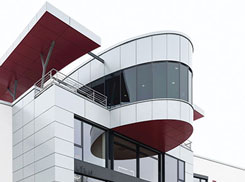
Dimmable Glazing for New Eckert & Ziegler AG Headquarters, Berlin
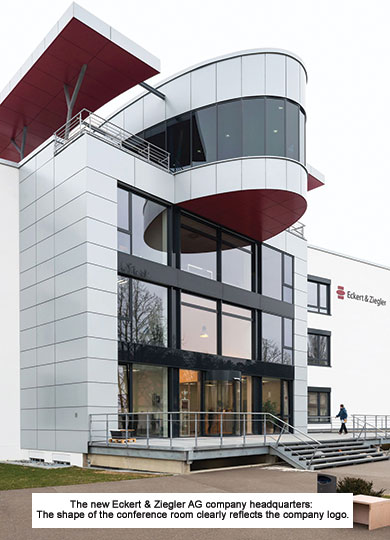
The Eckert & Ziegler group is one of the worldwide largest manufacturers of radioactive components for medical, scientific and metrological applications, with locations in Great Britain, France, India and the US. Due to increasing numbers in sales and employees, the company started a contest for a 5,000-square-meter extension of its headquarters at the biomedical science campus Berlin-Buch in 2011.
The owner wanted to incorporate its company logo - an ellipse encased by a rectangle - to be structurally integrated into the design. This was fulfilled by Hofmann Architekten in the form of an energy-efficient design, featuring an exposed conference room in the geometrical shape of the logo. "With the extending roof and the rectangular, red-painted roof elements, the building is clearly recognizable as the Eckert & Ziegler headquarters, even from the air," explains architect Jan Hofmann. The conference room, with all-around and nearly room-high glazing, offers a 180-degree view over the Berlin district of Buch.
| Credits board | |
| Project | : Eckert & Ziegler headquarters, Berlin, Germany |
| Building owner | : Eckert & Ziegler Strahlen- und Medizintechnik AG |
| Architect | : Hofmann Architekten, Berlin, Germany |
| Façade construction | : Hauk Metallbau und Sicherheitstechnik GmbH, Nauen, Germany |
| Glass product | : ECONTROL 48/9 |
| Photo Credit | : Linus Lintner Fotografie/ EControl-Glas |
Why Dimmable Glazing?
Due to concavity and southern orientation of the building, approx. 60 square meters of façade glazing are exposed to direct sunlight almost all day long. In order to keep the room from heating up as well as to prevent distracting glare, highly efficient solar protection was needed. "A variable external shading system would have been difficult to install and maintain due to the shape of the building. Rigid solar protection, however, does not let enough light during the winter months. The solar gains are minimal then," explains Hofmann.Also of major importance were the aesthetic demands of the owner, "The outside of the building had to be as smooth as possible. A shading system would have ruined the conference room's optical representation of the Eckert & Ziegler logo. We thus opted for the dimmable solar control glass ECONTROL 48/9," says Hofmann. Its solar factor is continuously adjustable between 33 and 9%. This eliminates the need for additional shading and the view from the conference room remains unobstructed. The transparency at maximum coloration is still 13%.

And this is how it works: The internal nanostructured coating of the EControl glazing is tinted blue by the so-called "electrochromic effect," as soon as a low voltage (3 volts) is applied. When set at 'light', 48% of the daylight will enter the room, a good value for modern solar control glazing. At a Ug value of 0.7 W/(m²K), ECONTROL 48/9 also provides excellent protection against heat losses.
"EControl glazing has proved to be the perfect solution for our energy-efficient and optically sophisticated concept. The innovative electrochromic technology also perfectly fits a modern, future-oriented company such as Eckert & Ziegler", adds Hofmann.
The new office of Eckert & Ziegler AG has an extending roof with rectangular, red-painted roof elements.
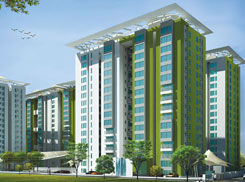
Green Athens - The Best of Both Worlds

Green Tree Homes and Ventures' latest luxury villa project spread across 3.16 acres, Greenn Athens offers 40 exclusive villas set amidst alluring surroundings with best-in-class amenities.
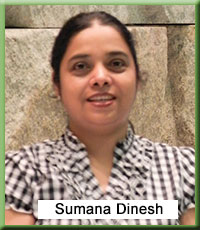
The thoughtful emphasis on location by Green Tree Homes comes through clearly in their latest offering – Greenn Athens. The pristine project is ideal for home-seekers weary of noisy city centres, but still keen to live within striking distance of amenities found in metro cities. Such thoughtfulness is not surprising with Green Tree Homes and Ventures, considering the promoters' track record. Promoted by a group of veteran architects and designers with more than two decades' experience in real estate projects that include integrated townships, Green Tree's team of experienced consultants fand developers employ global best practices and international standards of mechanized construction to ensure speedy delivery and absolute customer satisfaction with all projects.
Till date, Green Tree has numerous residential and commercial projects to its credit, covering more than one million square feet. The painstaking planning, strict adherence to building laws and regulations, with dedication to complete the projects ontime ensures customers that they are always offered excellent value for money. Moreover, Green Tree Homes endeavours to provide eco-friendly homes to customers at no extra cost.
Old-World Charm
Greenn Athens now augments the company's exemplary track record. The project name embodies some of the old-world charm of the ancient Greek city. One of the world's oldest cities, Athens has been renowned for its breathtaking architecture, comprising an eclectic mix of avant-garde design and culture. With its independent luxury villa community spread across 3.16 acres, Greenn Athens recreates just that nostalgic feel – right within the precincts of Chennai.
Hidden in a quiet corner of Chennai's Kelambakkam – nestled between the scenic East Coast Road (ECR) and the fast-developing Old Mahabalipuram Road – Greenn Athens offers home-seekers the best of both worlds, old as well as new, through the peaceful backwaters of ECR and the bustling industry of Chennai's IT valley. But that's not all, Greenn Athens is located close to the Muttukadu Lake. Which apart from being so pleasing to the eye, the lake is fast emerging as a hot tourist destination for water sports. Given its excellent location, both naturalists and adrenaline junkies will feel at home.
In this unmatched ambience, Greenn Athens presents an elegant canvas of 40 regal, pearl-white villas. Ensconced within a spacious 4,000–5,000 square feet, each of the 40 villas will have four bedrooms and three car parks, including an exclusive terrace, swimming pool and private elevator. Inspired by contemporary Greek architecture, Greenn Athens' villas display refreshing blue highlights, eye-catching Greek motifs and simple-yet-elegant lines. Blended harmoniously with the surroundings, the premium project recreates a Paradise-like image of Greece that enraptures every onlooker. As one walks through Greenn Athens, it becomes clear that there is so much to experience – across all four floors of each villa.
Enchanting Experiences
The magical experience starts to unfold the moment one enters the complex gates. On entering, one first notices that the lanes between villas are skillfully elevated to conceal the car park at the stilt level and provide two unique bridge-walks for leisurely strolls. Besides, the ample car parking space, the stilt level has a lap pool and deck for residents to relax within and to keep their bodies toned. From here, an in-house elevator carries residents to any floor they wish to visit including the beautifully landscaped terrace. Despite being indoors, the soothing sprays of green and open spaces sprinkled throughout the villa transform the indoor experience into a bright, airy, enchanting encounter.The close attention to detail ensures each home is perfect with plenty of flourishes for residents to flaunt that could undoubtedly floor visitors. Some of these include: in-house passenger elevator, lap pool, landscaped gardens, home theatre, Jacuzzi in master bath, bridge-walks, imported marble flooring, teakwood doors and architraves, and imported modular kitchen, among other amenities.
With imported marble skirting in living rooms, rustic tiles on the balconies, laminated wooden flooring in bedrooms, granite, ceramic tiles and best-in-class kitchen and toilet fittings, Greenn Athens is a dream home which has come true. Furthermore, it assures guilt-free indulgence as the project's contribution to the ecology has already been taken care of. Other amenities include: a 90-cm electric chimney, four-burner cooking hob, microwave, and dishwasher. All the rooms are provided with split AC ducting and the entire complex is Wi-Fi enabled. With 100% power back-up, including air-conditioning, all residents are assured that the scorching Chennai heat will barely make its presence felt.

The residents who are still in search of an exclusive experience and seek to add a personal touch to their homes, Greenn Athens offers the option of doing exactly the same. Whether it's picking up an East or West-facing villa, or deciding from multiple layout alternatives, Greenn Athens offers customers various options to decide how their home should look like. If customers don't wish to exercise their grey cells on the interiors, preferring to leave this to the experts, Green Tree can arrange to have their interiors done up by the super-skilled designers of a sister concern, Sumana Dinesh Associates. In such a scenario, home owners only need to pack their belongings and move to a beautifully crafted villa.
Finally, for all the opulence and luxurious living on offer, each villa is reasonably priced at Rs.3/- crore only, offering customers absolute value for money. Considering all the alluring amenities, it would come as no surprise if Greenn Athens becomes another best-seller for Green Tree Homes and Ventures.
Green 201: Eco-friendly Towers
Prior to Greenn Athens, Green Tree Homes has had other best-selling projects to its credit. The company gave Chennai its first entirely eco-friendly green residential complex in the IT Hub – Green 201 – constructed to high international standards and with eco-friendly features. The 15-storeyed building with five towers comprising 565 apartments has an exclusive garden on each of its floors, no wall sharing between apartments, a leaf-shaped amphitheatre and a rooftop clubhouse.A fully-landscaped terrace, rooftop swimming pool, gymnasium, tennis

Harpa Reykjavik Concert Hall & Conference Centre, Iceland

Harpa Reykjavik Concert Hall and Conference Centre in Iceland gathers inspiration from the northern lights and the dramatic Icelandic scenery. Designed by the Danish firm Henning Larsen Architects in co-operation with Danish-Icelandic artist Olafur Eliasson and the engineering companies Rambøll and ArtEngineering GmbH from Germany, the structure consists of a steel framework clad with irregularly shaped glass panels of different colors.
| Project at a Glance | |
| Architects | : Henning Larsen Architects & Batteriid Architects |
| Locations | : Reykjavik, Iceland |
| Client | : Austurnhofn TR – East Harbour Project Ltd. |
| Project Year | : 2011 |
| Project Area | : 28,000 sqm |
| Photo Credit | : All Images - Nic Lehoux |
| Façade design and development | : Olafur Eliasson and Studio Olafur Eliasson in collaboration with Henning Larsen Architects |

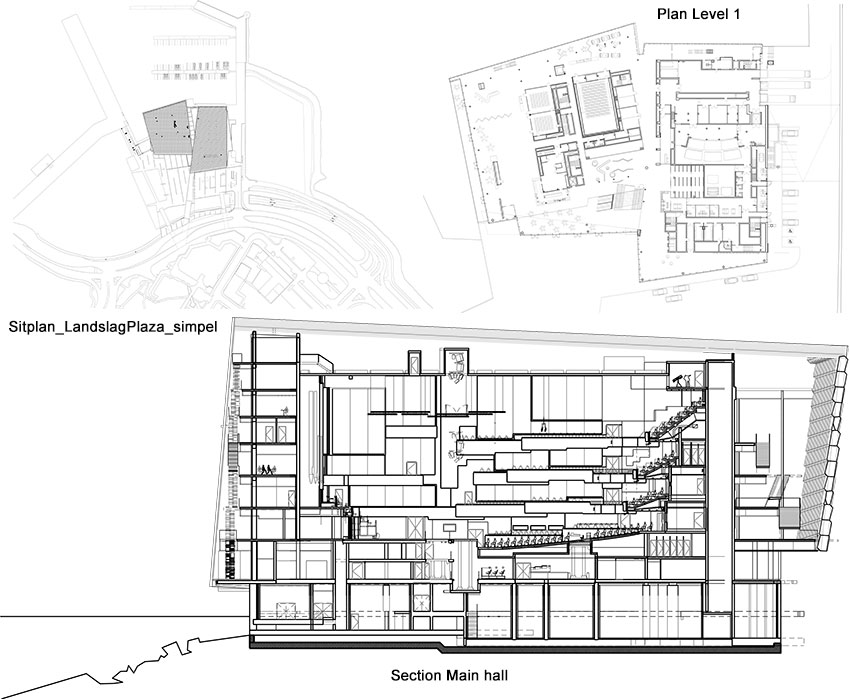

Situated on the border between land and sea, the Concert Hall stands out as a large, radiant sculpture reflecting both sky and harbour space as well as the vibrant life of the city. The Concert Hall of 28,000 m2 is situated in a solitary spot with a clear view of the enormous sea and the mountains surrounding Reykjavik. The building features an arrival and foyer area in front of the building, four halls in the middle and a backstage area with offices, administration, rehearsal hall and changing room in the back of the building. The three large halls are placed next to each other with public access on the south side and backstage access from the north. The fourth floor is a multifunctional hall with room for more intimate shows and banquets.

Seen from the foyer, the halls form a mountain-like massif that similar to basalt rock on the coast forms a stark contrast to the expressive and open facade. At the core of the rock, the largest hall of the building, the main concert hall, reveals its interior as a red-hot centre of force.
Facades
Henning Larsen Architects has designed the facade of the Concert Hall in close collaboration with the local architectural company Batteríið Architects and the Danish-Icelandic artist Olafur Eliasson.
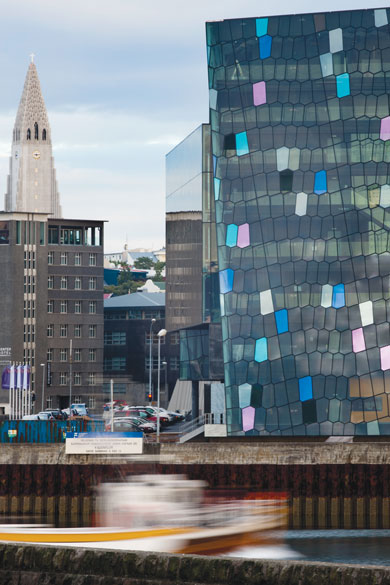
Made of glass and steel in a twelve-sided space-filling geometric modular system called the 'quasi-brick', the building appears a kaleidoscopic play of colors, reflected in more than 1000 quasi-bricks composing the southern facade. The remaining facades and the roof are made of sectional representations of this geometric system, resulting in two-dimensional flat facades of five and six-sided structural frames. In order to develop these ideas the team worked with three-dimensional computer models, finite element modeling, various digital visualization techniques as well as maquettes, models and mock-ups.
Light and transparency are key elements in the building. The crystalline structure, created by the geometric figures of the facade, captures and reflects the light - promoting the dialogue between the building, city and surrounding landscape.
One of the main ideas has been to "dematerialize" the building as a static entity and let it respond to the surrounding colors - the city lights, ocean and glow of the sky. In this way, the expression of the facade changes according to the visual angle. With the continuously changing scenery, the building appears in an endless variation of colors.
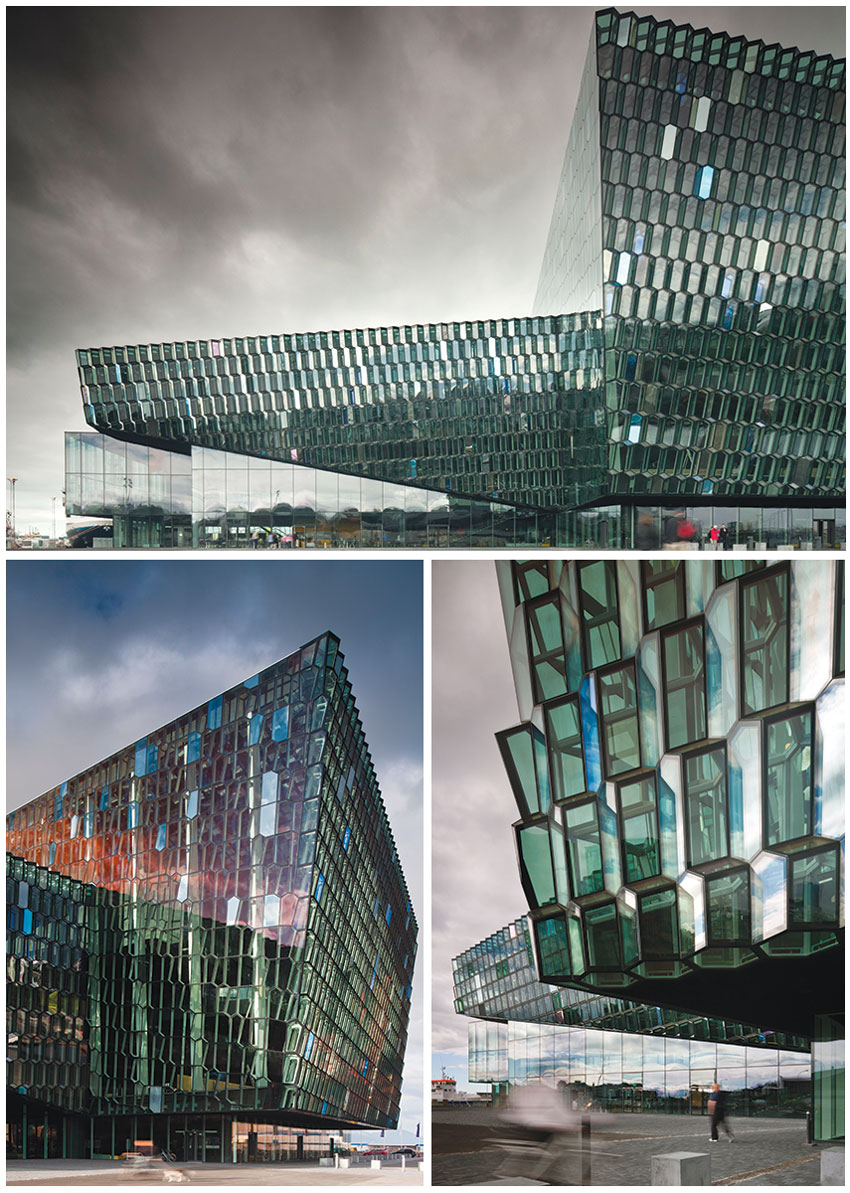
The new concert hall in Iceland, Harpa, is one of five projects that have been announced as finalists for one of the most prestigious awards in architecture, the Mies van der Rohe Award. It is only the second time in the history of the award that a Danish designed project is in the final.

New Spiegel Building Hamburg - The window to the City
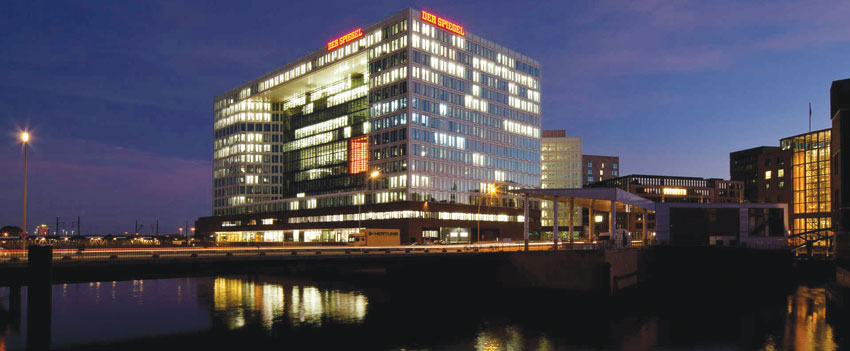
| Project facts | |
| Location | : Brooktorkai, HafenCity, Hamburg, Germany |
| Client | : Robert Vogel & Co. |
| User | : Spiegel Group |
| Gross floor area | : 50,000 m² |
| Year of construction | : 2008 - 2011 |
| Architects | : Henning Larsen Architects and Höhler+Partner |
| Landscape | : WES & Partner Landschaftsarchitekten |
| Engineers | : Ingenieurbüro Dr. Binnewies, DS-Plan and ISR Schlegel und Reuβwig |
| Façade builder | : Schindler Fenster & Fassadenbau GmbH, Roding |
| Glass processor | : Interpane Belgern |
| Light Design | : Kardorff Ingenieure |
| Photo credit | : Cordelia Ewerth and Andreas Gehrke |
The new Spiegel headquarters and the neighboring office complex, the Ericus-Contor, a fourteen and nine-storey building pair, expand the gallery of internationally recognized architectural works in Hamburg. The publisher's headquarters and office block, two impressive examples of glass architecture, stand together on the same brick base. The buildings, nestled in the Ericusspitze, with their irregular trapezoidal ground plan, were designed by the Danish firm Henning Larsen Architects. Seen from the north side, the 61-metre-high Spiegel editorial building looks like a window on the town and lets the viewer see deep inside. The glass shell can be used for multimedia projections; it is also part of the reason for the building's outstanding energy balance. ipasol neutral 68/37 solar control glass and iplus E thermal insulation glass from Interpane ensure that the rooms are flooded with daylight, without overheating in the summer sun or losing heat on cold days.

"Location, location and location" The Ericus Quarter is a prime waterfront setting near Hamburg's "Docklands" the "Speicherstadt" just minutes on foot from the city centre and the central station. Visitors appreciate its maritime flair and the sight of the old façades around the Brooktor port. Here, at the north eastern entrance to the "Harbour City", the headquarters of the Spiegel Group and the Ericus-Contor which emerge out of a common brick base have an unbeatable panoramic view of the port.
Structural Design
Henning Larsen Architects has chosen a two-part composition to create hierarchy and openness on the site and has integrated the complex urban spaces that meet at Ericusspitze in their design. The two buildings are designed as large U-forms that embrace the urban space they are directed towards. The Spiegel building embraces an internal space with a more urban character because of its direction towards the city. The Ericus building embraces an open, green outdoor space as it directed towards the large open Lohsepark.

The two buildings form two plazas: an arrival plaza for pedestrians, cy-clists and drivers towards Brooktorkai and an open public plaza, which has a direct connection to the waterfront promenade.
With total space of 30,000 square meters, the new Spiegel office building is one of the largest in Hamburg which comprises 13 stories. Its windows are framed with white metal and the glass facades resemble austere grids, but the north side of the building is more open to which the architects call it a "window to the city." Besides these, the building to its inside has an atrium as high as the building itself, flanked by galleries and crossed by nine staircases and four bridges. Here, too, the architects wanted to create an image of networks, transparency and communication.
Outstanding Sustainability
Spiegel Headquarters has been awarded with the prestigious award 'Hafencity Umweltszeichen Gold'. The building is certified with a gold medal in the certification system of HafenCity for meeting the highest sustainability requirements for buildings in Germany. The certificate is awarded for sustainable utilization of energy and public resources, the use of environmental-friendly building materials, the consideration of health and comfort aspects and also for the sustainable construction and operation of the building. The calculated energy consumption of the Spiegel building amounts to only 80 kWh/m2/year.Energy consumption, sustainable materials and a good indoor climate are the factors that have been carefully examined since the design phase. During the selection of materials and products for the buildings, all of them have been carefully examined and evaluated on the basis of their performance (easy to clean and should not be allergenic) to ensure a good indoor air quality.

With its unusual construction, built by façade builders Schindler Fenster & Fassadenbau (Roding), the headquarters plays in the premier league energetically as well as optically. Almost all the façades of the building are covered with triple insulation glass in a beam-and-column construction. On the ground floor, in the highly transparent structural glazing façade of the central part of the building and in the wide roof, ipasol neutral 68/37 solar control glass ensures colour-neutral transparency and an outstanding energy balance. Because of the low total energy transmittance (solar factor = 37% according to EN 410), the rooms behind the glass warm up less, removing the need for exterior shading. Nonetheless, lots of daylight (tV = 68%) reaches them. Light reflection on them is minimal, leading to a particularly colour-neutral appearance and maximum transparency. The light reflection from inside is also minimal, ensuring an outstanding view to the outside, even with the internal lighting turned on. The neighboring Ericus-Contor is protected with iplus E double insulation glazing and ipasol neutral 68/37 solar control glass.
The heating and cooling system is also clever: ground heat exchangers and photovoltaic panels reduce the need for non-regenerative energy; the glass façade is naturally rear ventilated - making classical air-conditioners and radiators unnecessary. Radiant heating and cooling panels on the office ceilings regulate the climate through gentle radiation, improving the sensation of well-being. The whole building is heated and cooled in this environmental-friendly manner, without preventing the manual opening of office windows.

Buffer Zone of Light and Fresh Air
The glass-covered atrium which spans all floors, creates a pillar of light and air surrounded by galleries. Whenever the employees move from office to office, or walk over the many bridges and stairs to another level, they have a clear view of the sky. The architects have succeeded in creating the perfect image of transparency, networking and communication. The colour concept of the interior is marked by white, often removable, wall panels, grey carpeting and lots of natural wood. Only the already almost legendary "colour explosion" of the snack bar from the old building consciously falls outside this mould. The designers shipped this homage to earlier times to the fifth floor: coloured prisms of fabric, wall-mounted and hanging lamps, mainly in bold orange and purple. It is safe to assume that this is the place where new recruits will be introduced to the myths of Spiegel history. An alternative is the cafeteria on the ground floor - with its terrace right by the water.
Floating and Moving Houses: A Need of Tomorrow
"Floating" term in the foundation engineering is used when the soil beneath the footing does not experience any extra load, as the load of the structure is equal or less than the soil displaced. Floating houses are similar in concept and can be defined those houses which are constructed on water in a way that the load of the structure is equal or less than the uplift force of the water which helps in floating the house on water. Traditional houses like houses on boats have mobility while now floating houses are considered those houses which are used as living spaces on water that are minimally mobile other than moving vertically with the tide. Unlike a houseboat, a float house is not self-propelled though some smaller float houses can be propelled by attaching an outboard motor to them. Holland has many float houses as they have started using water as a resource for construction of houses.
Traditional floating houses, normally houseboats, were built in various countries in the places prone to floods, near coast lines and on the lakes and rivers. In Australia, especially on the Murray River and the sunny coastline of Queensland, there are many motorised pontoon based houseboats with two or more bed rooms, some of them even have multi-storeyed structure. Houseboats are also in Lake Eldon in Victoria and in Hawkesbury River near Sydney. Similarly floating houses/houseboats are available in Canada, Germany, Hong Kong, Laos, New Zealand, Serbia, UK, USA, Thailand and India. In India, houseboats have been traditionally constructed in Kashmir, Kerala and in Assam. Houseboats are also very popular for recreational activities for groups of people of all ages but for residential purposes, it is Holland where houses are designed, constructed and are in high demand.

Floating houses are now constructed which float only during floods. Thus, there are two types of floating houses, one which permanently float and other that float only during flood waters else get placed on ground, particularly during dry season when there is no water. Some houses which were constructed on stilts or piles due to safety requirements during floods in many parts of the world and in India too, like in West Bengal, Assam and other parts, are not actually floating houses in true sense. Floating houses are in true sense are those which do not require foundation and are based on the principle of buoyancy thus are also called buoyant homes. Thus the base of the structure needs to be such that it helps in floating as well able to take the dead load of the house, live load and other loads to be encountered by the house. Thus the house may be constructed on boats, hollow pipes, light weight pads and similar materials which help in the floating as well taking up loads. Flotation Systems now being used include log floats, solid Styrofoam encased in rubber, foam filled steel pontoons, positive concrete, concrete ferrocement pontoons, concrete and foam, wood and foam, polyethylene shell with solid core polystyrene block moulded inside, fibreglass etc.
Houses which get uplift during floods and move down during conditions when no water is there are guided vertically, telescopically. A steel frame that holds the flotation blocks is attached to the underside of the house. There are four 'vertical guidance' poles not far from the corners of the house. The tops of the poles are attached to the steel frame. The poles telescope out of the ground, allowing the house to move up and down.
Need of Floating Houses

One Dutch construction company, recognising the growing scarcity of land in the Netherlands started to build houses on water. Ooms Bouwmaatschappij has built the first eight of 500 planned floating houses on the outskirts of Amsterdam, the capital of the world's third most densely populated country. The houses, which are designed to withstand gales, are built on floating platforms. Frits Schoute, a former professor at Delft University, is working on a stabilising platform that would permit communities to live in the middle of oceans, unaffected by waves. He expects colonisation by these floating cities to take place in the next 20 years.
Basic Principle of Construction
Generally there are two basic principles for making floating houses. First is the pontoon principle in which one makes a solid platform, lighter than the water and the other based on the ship in which a hollow concrete box is created which is open on the top. The pontoon principle has the benefit of its use in shallow water, compared to the hollow concrete box while the concrete box has the benefit of higher space utilisation within as a part of the building. Both type of floating houses are connected with a flexible connection to the quay, so the houses can rise with the water when the tide changes. When needed the floating system can be moved elsewhere at short notice without leaving any scar to the environment. Instead a new house can be placed in to the old situation which makes it the most sustainable and durable way to build. The floating houses built by +31architects are based on the hollow concrete box.The house is sited within a wet dock comprising retaining walls and base slab. When flooding occurs the dock fills with water and the house rises accordingly. Similarly when water subsides, houses come down. All the pipes, ducts and wires for water, gas, electricity and sewage disposal in such "amphibious" homes are flexible, designed to remain functional even when the house rises several metres from its usual position. Amphibious homes that rest on land are also built for rising conditions. As per the designers, Factor Architecten, when the river has the flooding conditions, their houses will float as much as 18 feet and floats back down as the water subsides.

Providing services in a floating house is a challenge which includes water supply, electricity and toilets. Therefore, green building concept has to be followed in the floating houses which use non conventional resources for energy, make use of waste products, and recycles the water. Net zero energy buildings are more useful as they do not require additional energy from external source and total energy demand is met from on site generation power. Normally solar panels are provided for the energy requirements. Due to aesthetic requiurements as well energy efficiency, roof garden is also becoming popular. Other measures like incinolet toilets to burn waste, geothermal pond loops into the floor, and filtration unit for drinking water collected from rainstorms. 'New Water', Netherland planned for using 25% less energy than a conventional building due to the use of water cooling techniques.

Life in a Floating House
If some one is fond of relaxing atmosphere, romanticism and living on the water, there are plenty of reasons to live on a floating home. Recurring cost on electricity and water though high, may be reduced through providing non-conventional energy sources. The calming nature of living on the water takes such house owners away from the hustle and bustle of city life but the main advantage is the safety during floods being a necessity in some of the areas like in Netherland. Also such houses can be integrated with beautiful landscape and comfort conditions with minimum energy bills and a small carbon footprint. These can be workshop made high quality homes delivered to site complete with required interior and exterior finishes, windows, doors, fixtures, and appliances.
The most prominent con of life on the water is the drastic changes in the lifestyle. There is limited space particularly for storage therefore possessions has to be kept to a minimum. Main problem is the cost and inconvenience of heating in the winter time and maintenance and repair if required.
Floating Structures
Though there are several floating structures now existing and in planning stage, few planned big structures are mentioned here.Floating island Seoul: In Han River in Seoul, South Korea, the floating island has the stunning structure includes a 700 seat convention hall, restaurants and arcades - all powered by solar energy (http://inhabitat.com/worlds-first-solar-powered-floating-island)

Floating hotel: The connecting bridge is planted with trees, giving the impression of land projecting into the sea and is designed by the Giancarlo Zema Design Group for an Arabian commission. www.giancarlozema.com
Floating city: Planned for 2015 completion in the Maldives. The green covered star-shape building symbolizes the Maldivian innovative route to conquer climate change. This will become a location for conventions about climate change, water management and sustainability. Architect Koen Olthuis--Waterstudio.NL. Developer Dutch Docklands--www.dutchdocklands.com.

Miniature Taj Mahal: The most famous of the Sausalito houseboats, a miniature version of the Taj Mahal in India has been for the last four decades a private home, although it was a bed and breakfast for a few years, now it's a private home again. www.flickr.com
Moving Houses
There are mythological stories where it is mentioned that constructed houses were removed, taken somewhere else and thereafter again shifted at the same place. In Ramayana, Hanumanji uprooted the mountain so also the house of Vaidya Sushain. After the treatment, the house was reinstalled at the same place. There are stories of Sindbad in which houses were taken on the carpet and reinstalled. It only shows that it was possible to shift some of the houses though instances of flying houses are not available. Flying a house is feasible only if it is supported on mat having less dead weight and live load than the air pressure, if constructed on the theory of balloons.
Moving houses are comparatively easy to construct. In one of the case, an envelope of the floating house was fabricated at the fabrication yard and towed away for about 80 km on the lake, finally anchored. Thus there is a possibility where the envelope of the houses can be fabricated, shown to the customer and towed to the site. The whole structure will require to be anchored to the foundation. In future, if house owner wants to shift it, it can be dismantled and reinstalled at other place. Interiors can be placed as per the requirements through modular parts like kitchen, baths etc. Such structures have a considerable market as it will be possible to erect the house within days that too as per the sample selected by the customer. Such houses may be successful in small places or even in cities where one can afford. Such structures can also be joined easily. In fact if a plate is fixed at the bottom to the structure which can take load of the envelope, it would be easy to shift it, anchor and even dismantle it for re-fixing. Plate will act like carpet in the Sindbad stories.
In the islands and coastal areas, such houses will certainly be adopted sooner or later and thus Indian architects and designers should start getting expertise in this field to design such houses.
Floating houses can also be built for tourists who would love to stay in such houses and India can generate considerable revenue from the same.
Moving houses are comparatively easy to construct. In one of the case, an envelope of the floating house was fabricated at the fabrication yard and towed away for about 80 km on the lake, finally anchored. Thus there is a possibility where the envelope of the houses can be fabricated, shown to the customer and towed to the site. The whole structure will require to be anchored to the foundation. In future, if house owner wants to shift it, it can be dismantled and reinstalled at other place. Interiors can be placed as per the requirements through modular parts like kitchen, baths etc. Such structures have a considerable market as it will be possible to erect the house within days that too as per the sample selected by the customer. Such houses may be successful in small places or even in cities where one can afford. Such structures can also be joined easily. In fact if a plate is fixed at the bottom to the structure which can take load of the envelope, it would be easy to shift it, anchor and even dismantle it for re-fixing. Plate will act like carpet in the Sindbad stories.
Need of Floating Houses in India
India has a huge coastal area as well as large flood prone areas like Bihar, Assam and in many other states where almost every year, public face difficulty due to floods and loss of lives and property takes place. In case, the principle of construction of floating houses is adopted in which the houses would rise during floods and subside down during dry conditions, loss of lives and property can be avoided. Simple techniques based on telescopic arrangements should be designed for requirements. Therefore, research and development can be taken up as model projects for developing such designs. In the starting, life line buildings in the flood prone areas can be constructed with such techniques. These buildings will function even during period when they remain cut off due to floods and have no external electricity and water.In the islands and coastal areas, such houses will certainly be adopted sooner or later and thus Indian architects and designers should start getting expertise in this field to design such houses.
Floating houses can also be built for tourists who would love to stay in such houses and India can generate considerable revenue from the same.
Conclusions
Floating houses may be the need for the future in coastal areas and flood prone areas in India also and thus researchers, architects and engineers should have capacity in designing and building such houses to meet the challenge of coming time. Concept of transportable ready built houses should also be started particularly for row houses and for government aided schemes which would prove to be quality expandable homes and can be constructed in quick time as per the budget availability.References
- http://hausmanllc.wordpress.com/tag/floating-homes, buoyantfoundation.org, www.mos-office.net, http://www.floating-homes.co.uk/guides/floating_home_life.php, waterstudio.nl., inspirationgreen.com/floating-homes.html, www.kashmirhouseboats.com, www.rohmer.nl, http://www.ecoboot.nl/artikelen/floating_houses.php, www.vc-arch.com
- en.wikipedia.org/wiki/Houseboat, powellriverbooks.blogspot.com, buoyantfoundation.org,
- +31ARCHITECTS: Specialist in Constructing Floating Water House, MGS Architecture January - February 2011
- Soni, K M and Soni, Piyush (2013). Floating and Moving Houses, Journal of Indian Buildings Congress, XX (2), 17-22.
- Do it yourself book - Ferrocement Floating House. International Ferrocement Information centre Asian Instt. of Technology Bangkok (Thailand)

Work-Live-Play: A new mantra for hassle-free life
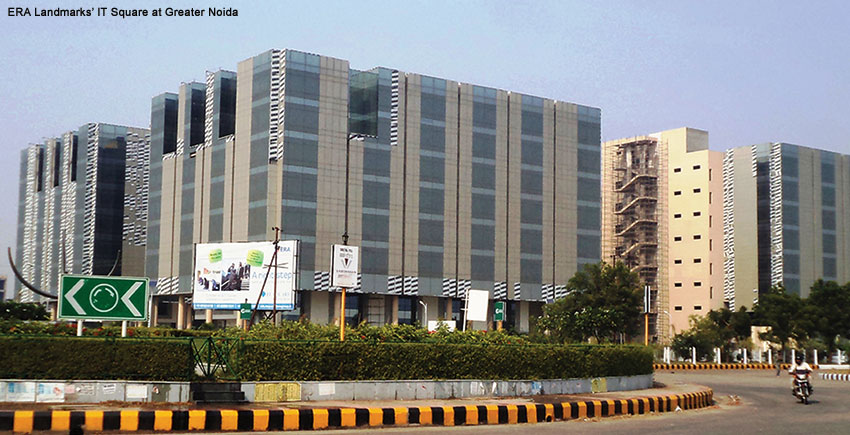
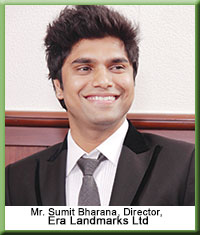
It brings into picture the thought of combining studio apartments-offices-commercial hubs under single roof. Highrise buildings, long working hours, traffic congestions, polluted roads and densely populated areas—ideally define a metropolitan city. The so called "speediness" has ravished the real essence of life. People from small towns migrate to cities for a healthy lifestyle, but often find themselves stuck in the amidst of rush and tensions.
The war is about the grip on the rat race, to survive, to boost one's ego by possessing a dream flat and a car in a well heeled part of the city. We hardly spend time with friends, an occasional forwarded sms generally takes care of that. Celebrations have transformed into the once in a while formal get together. A normal day in most of our lives usually starts from a prescribed breakfast by the friendly dietitian, work out in the gym under the vigilant eyes of the trainer, rush to the office (if you have a car you are perhaps the luckiest one, else wait for the public transport and prepare yourself for the routine fight of finding a seat in a bus), come back home after long hectic travelling hours and spend some time with your family (if your body authorizes that), go to sleep and start all over again the next morning.
These cities have become so populated and polluted to its optimum level that eradicating long travelling distances between work, home and amusement, is a contemporary necessity of the young professionals.
So, more desirable travel patterns have given rise to a new concept called Work-live and play, which is a boon and can fulfill all the present day needs, making life more trouble-free and joyful. It ideally means, obtaining three vital components of any working professional's lifestyle, that is, a convenient place to live, a suitable place to work, and an exciting place to enjoy, located inside one estate. In a straight line, it shows an easy escape from the dusty, polluted and noisy traffic hours.
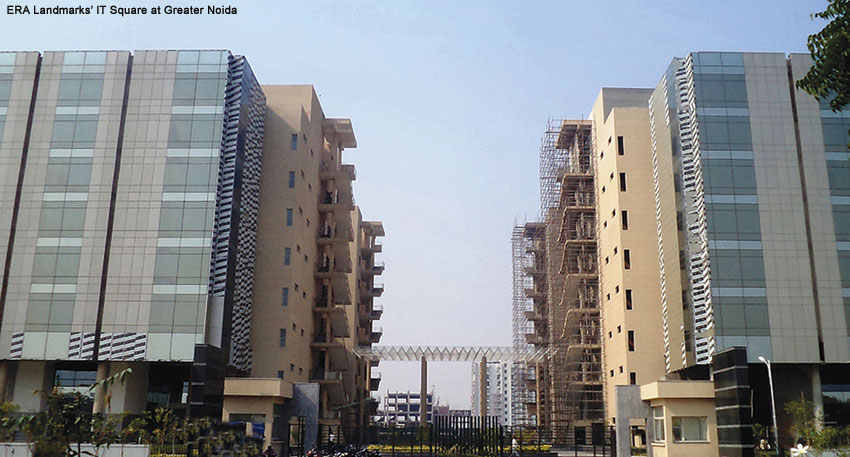
That's something most of us strive for, and the new trend for achieving that goal is to move in such localities. This idea may sound untried, but it has been around since the 1980s in spirit and is banging again in many metropolitan areas.
A Complete Recreational Package
Undoubtedly, life in big cities has become faster and people are always bound in a specified time frame but developers now a days are busy building such an infrastructure which can cater all the recreational facilities and a home to stay, closer to the office premises. Reports of the health organizations reveal that most of the people in the metropolitan cities suffer from respiratory problems due to high levels of pollution.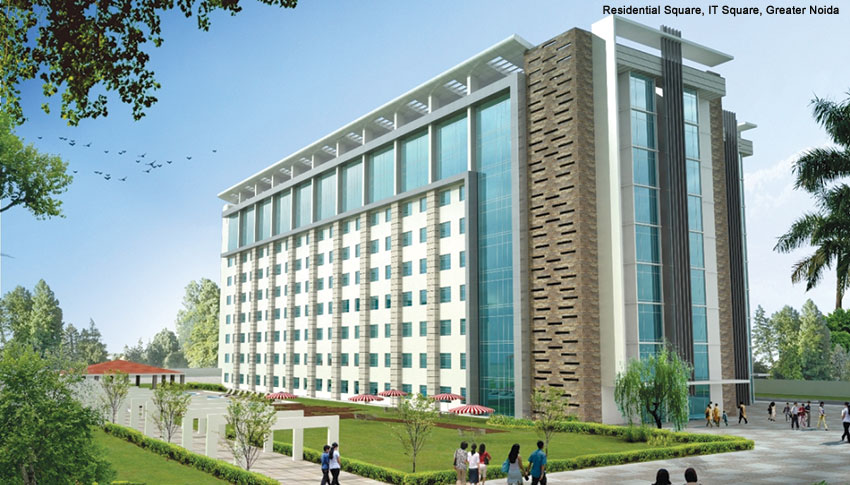
Although these cities provide many employment opportunities but they fail to provide a peaceful life. The time wasted in jams and congestions reduces the competence of the people and leaves no space for leisure. Higher education, extreme ambitions, efficiency —the basic attires of todays workforce, have raised the momentum of work-live-play concept in India.
Developers are pattering into the growing demand for this concept by reconstructing all the infrastructure for building industrial estates and thus transforming them into the "elite class business parks" with a whole set of lifestyle facilities, including gymnasiums, grocery stores, movie theaters, walking trails, dog parks and the like. A suitable framework of active behavior, not only for adults but also for kids.

In addition, live-work-play communities are no longer limited to the metropolis. Now, they even pop up in suburban areas as a way to taste the conveniences of urban life.
Benefits of Work-Live-Play
The economy may go through cycles of peaks and troughs, but demand for real estate, in particular housing will always be there in India, till every single working professional dreams of owning a home. No matter how many jobs are sacked from a company, there will always be a need for a place to live. And considering the constant rise in the population of our country, realty market is bound to find a way out to bring people out of this competitive environment.It's an easy option to get rid of this frantic life and moving in close proximity to the family. Moreover, sharing the neighborhood with the people you work would be a great opportunity to build some lifelong healthy relationships. Parties, small trips and frequent visits at each other place would help to fabricate a strong social life. Maintaining balance between professional and personal life will be far simpler, as one can ever think.
In other words, this concept of work-live-play brings into picture the thought of combining studio apartments-offices-commercial hubs under single roof. It's time to enjoy life and get everything you need in one convenient place!
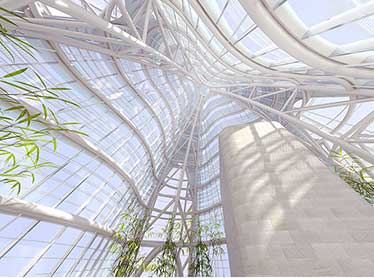
Wuhan Greenland Center, China
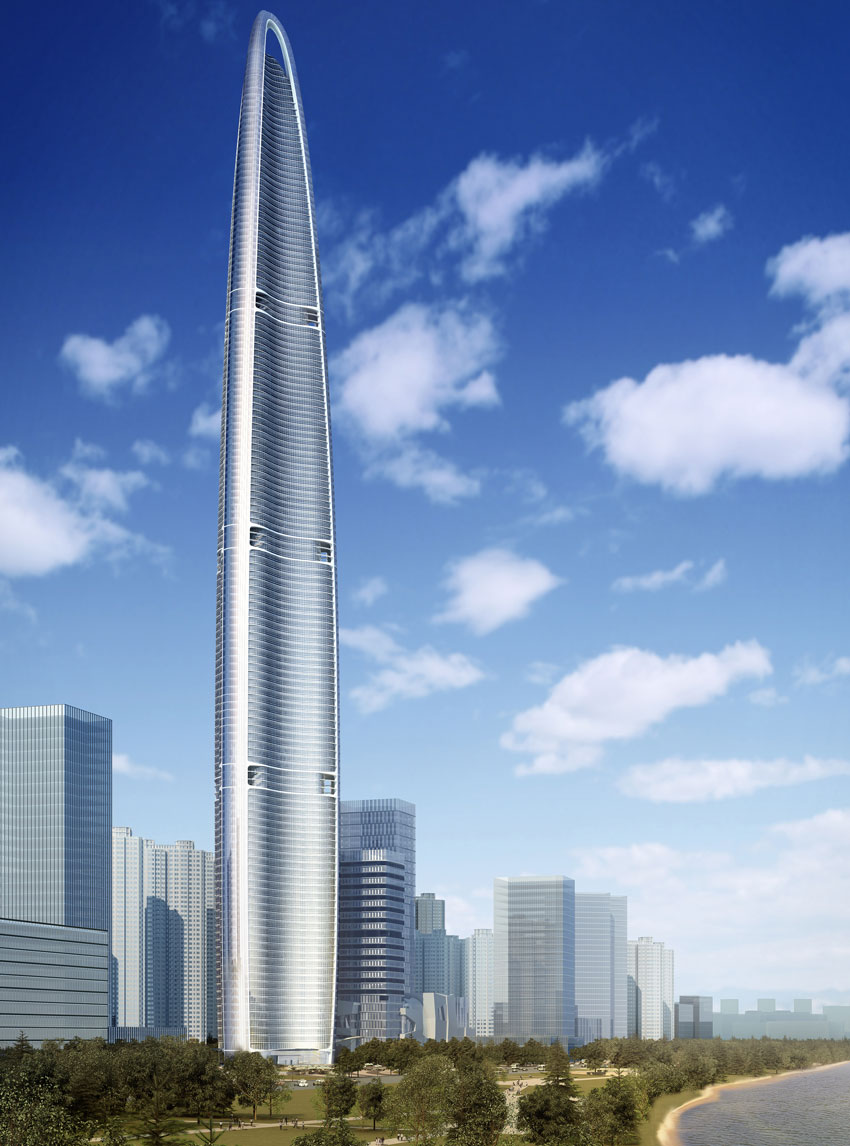
| At a Glance | |
| Project | : Wuhan Greenland Center, Wuhan, China |
| Architectural firm | : AS+GG Architecture |
| Engineer | : Thornton Tomasetti |
| Client | : Greenland Group |
| Function | : Mixed-Use |
| Height | : 606 m height |
| Start of Construction | : 2012 |
| Estimated Completion | : 2017 |
The Wuhan Greenland Center, at 606 meters (1,988 feet), is likely to become China's third-tallest and world's seventh tallest building, when completed in 2016. AS+GG Architecture in conjunction with Thornton Tomasetti Engineers won the design competition to build the 125 storey tower which comprises about 300,000 square meters of floor area, including about 200,000 sm of offices, 50,000 sm of luxury apartments and condominiums, a 45,000 sm five-star hotel, and a 5,000 sm, 27-meter-tall private club with spectacular views at the tower's penthouse level.
The tower features a uniquely streamlined form that combines three key shaping concepts-a tapered body, softly rounded corners and a domed top-to reduce wind resistance and vortex action that builds up around supertall towers. The building's extremely efficient aerodynamic performance will allow it to minimize the amount of structural material (and the associated embodied carbon) needed for construction.
Frame Work
The major structural system of Wuhan Greenland Center Main Tower consisting of robust composite walls, giant slightly sloping composite SRC columns and curved belt trusses, is adopted to resist the lateral loads (wind or seismic) effectively. The locations and geometry of structural components have carefully been optimized to not only provide enough strength and stiffness but also to integrate with the architecture seamlessly.The tower's three corners rise from its tripod-shaped base and taper upward, culminating in an arched tip above the dome at the top. The corners will be of smooth curved glass, contrasting markedly with the more textured curtain wall cladding the body of the tower. The curtain wall will enclose a composite concrete core with steel framing. Apertures in the curtain wall at regular intervals will assist in venting wind pressure against the tower; the apertures will also house window-washing systems and air intake and exhaust systems on mechanical floors.

Tower Crown Structure
The top of the Wuhan Greenland Center Main Tower is an expression of the project design philosophy. As the tower reaches into the sky, the cladding splits at the line between two architectural components known as the body and the shield. This separation was created to help alleviate tower top wind forces and thus significantly improve building behavior. This simple but powerful statement about the effectiveness of coordinating architecture and structure in Supertall building design has become the building's most iconic feature and is certain to create a landmark on the city skyline.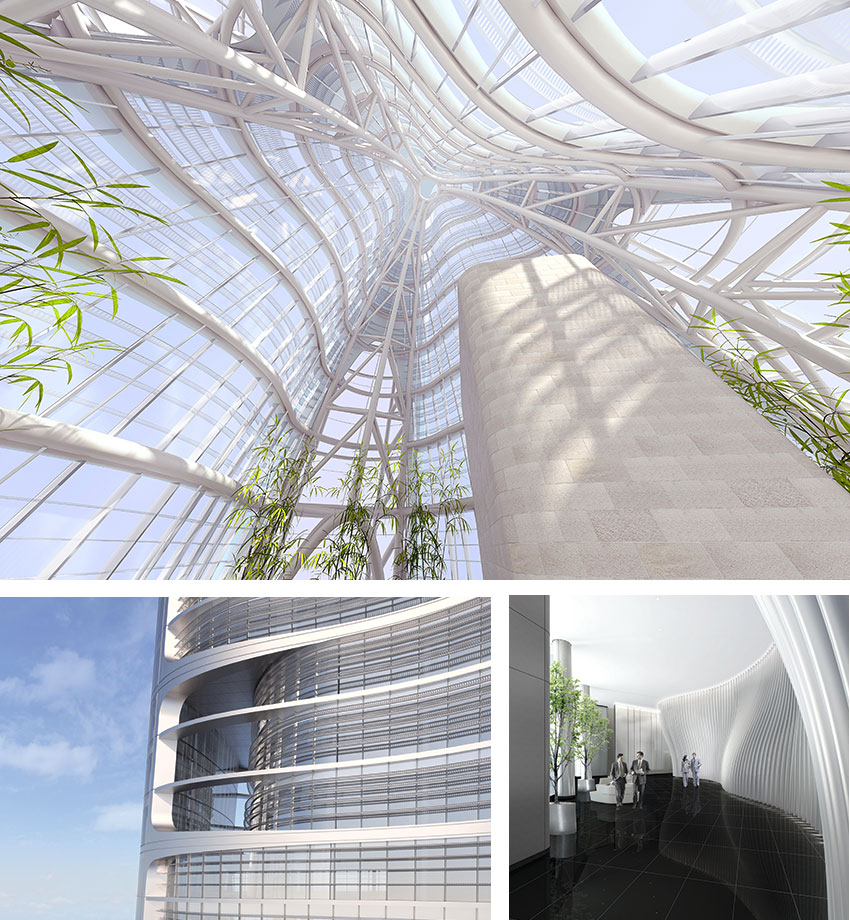
Rising from gently tapering tower wing tips, the taper steadily and continuously increases to the point that the tips converge on the tower centerline to form a unique 61m tall crown. Tapering of other building surfaces defines a 35m tall dome. Cleaning of the dome glass will be performed by equipment suspended from the crown above. Cladding of the outer crown is supported by a special tripod structural system. Because crown tripod leg framing is concealed within opaque cladding, support structural design was based on material efficiency and constructability. Each crown tripod leg, a half-arch in profile, is trapezoidal in cross-section or plan. The four faces of each leg are trusses following simple surfaces, with the upper/outer and side trusses triangulated for shear stiffness and the lower/inner truss a Vierendeel without diagonals. Pipes up to 500 mm diameter are used for truss chords and smaller diameter pipes are used for web members and braces. The inner truss Vierendeel configuration and the hollow tripod leg design without internal diaphragms were both selected to work with the window washing machine within. The side trusses taper nearly to a point at the crown base, landing on the super columns at wing tips and connecting directly to the embedded steel columns in the super column for secure load transfer.

Sustainable Elements
The tower has several other planned sustainable elements that include: Energy recovery using an enthalpy wheel integrated into the ventilation system; this captures energy from the building's exhaust systems and uses it to pre-heat or pre-cool air entering the building.It will have a greywater recovery system which takes waste water from the hotel laundry, sinks and showers and reuses it in the building's evaporative cooling system. Water-conserving low-flow plumbing fixtures, has been selected for this building which reduce the total amount of potable water required as well as the associated pumping energy.
Besides these, a high-efficiency lighting system has been planned which uses low-energy-consuming ballasts and lamps to reduce required power consumption. It has also a daylight-responsive control system, which automatically turns off electric lights when sufficient daylight is available.
In addition, the AS+GG Interiors studio is developing the tower's fluidly sculpted interior public spaces, many of which reflect the tower's exterior silhouette. The conical silhouette is visibly echoed in the entrances to the primary elevator bank from the main lobby, as well as in the shapes of the elevator cabs and other public spaces. The lobbies and other amenity spaces within the tower also feature sweeping, fluid lines and a neutral blue-gray palette that recalls the reflective glass of the exterior wall. The transparency of the ground-floor lobby wall allows views from inside toward the entry canopy drop-off areas, establishing a seamless relationship between the interior and exterior.
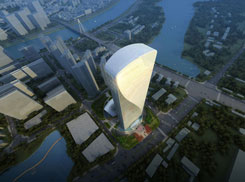
Qintai International Tower
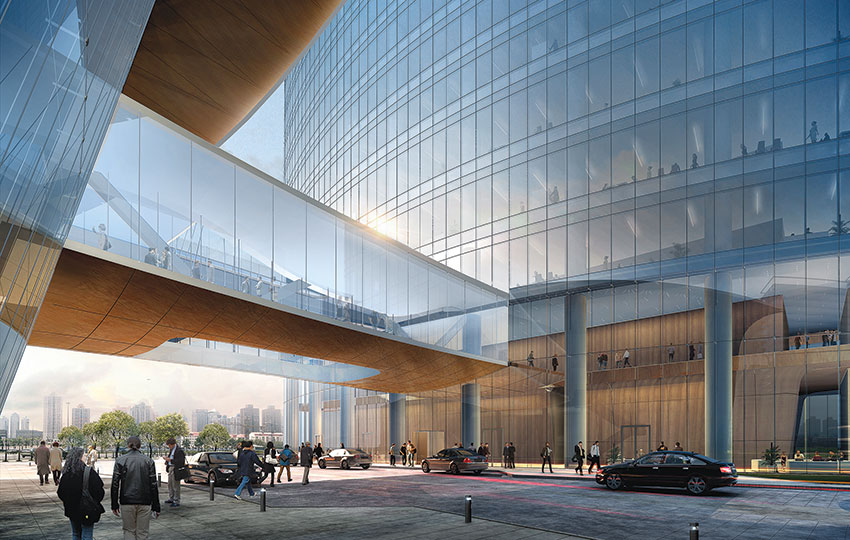
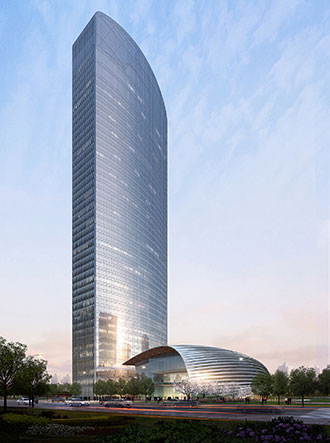
| At a Glance | ||
| Project | : | Qintai International Tower, Wuhan, China |
| Architectural firm | : | AS+GG Architecture |
| Client | : | Hubei Tobacco Company |
| Function | : | Mixed-Use |
| Height | : | 248 m height |
| Lighting Designer | : | Office for Visual Interaction (OVI) |
Qintai International Tower is AS+GG Architecture's winning design for an international competition to design a 248-meter (814-feet) tall, high-performance corporate headquarters tower and related podium structure in Wuhan, Hubei Province, China.
The Tower's total constructed area is 146,000 square meters, including a 5-star hotel and office space to be occupied by the client, CNTC Hubei Provincial Tobacco Corporation, and other tenants. The tower will be connected via a plaza and an above-grade pedestrian bridge to the podium, which will contain retail, restaurants and a conference center with a ballroom. At the top of the tower, a special executive lounge and restaurants will offer spectacular views of the surrounding cityscape.
The tower’s unique form is both culturally and environmentally contextual to the city of Wuhan. The genesis of the form in the competition phase related to the Qin, a traditional Chinese musical instrument similar to a zither, featuring strings that are stretched over pegs that form a raised S curve over a rectangular wooden frame. The instrument is similar to the one featured in a Chinese legend with deep significance to the culture of Hubei, which in turn inspired the design process.
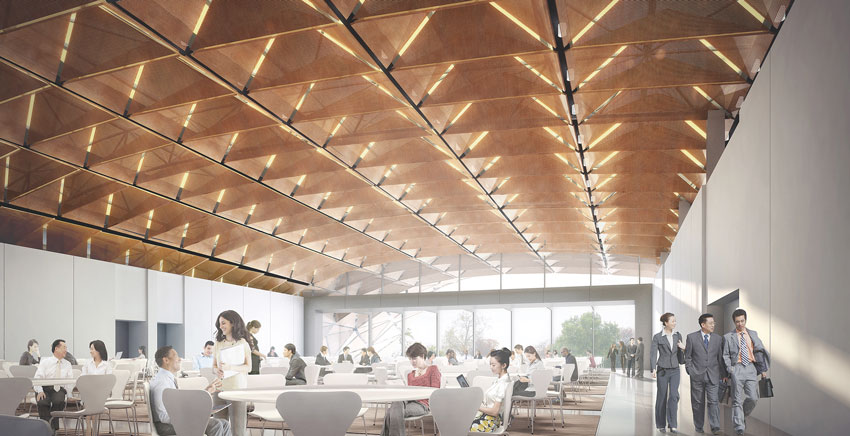
Sustainable Design Features
During the ongoing concept design phase, the cultural influence of the building has been developed in relation to the building’s energy performance. Informed by a rigorous parametric analysis, the façade now bows outward in a diagonal line that ascends northwest up the tower. This shape has been adjusted to optimize self-shading and minimize solar heat gain, an effect augmented by the fact that both the tower and podium’s narrowest exposures are mostly to the east and west, from which the sun is harshest. In addition, the tower’s smaller floor plates allow for greater use of daylight harvesting, which in turn reduces the building’s energy consumption for artificial lighting.

Floodlights are carefully aimed at the tower’s facade in order to softly catch the building’s elegant central curve, drawing the eye upward toward the shape of the glowing top-floor restaurant. Sparkling water features and glowing tea pavilions create moments of brilliance amongst the dense landscape of softly illuminated curving pathways, creatively lit by fixtures concealed in the branches of flowering trees.
Qintai International Tower is oriented to maximize views of Wuhan’s great bodies of water, including Moon Lake to the east and the nearby Hanshui River to the north. The building will also enjoy a perspective of the AS+GG-designed Wuhan Greenland Center, a supertall tower now in the early stages of construction about five miles from the Qintai site.
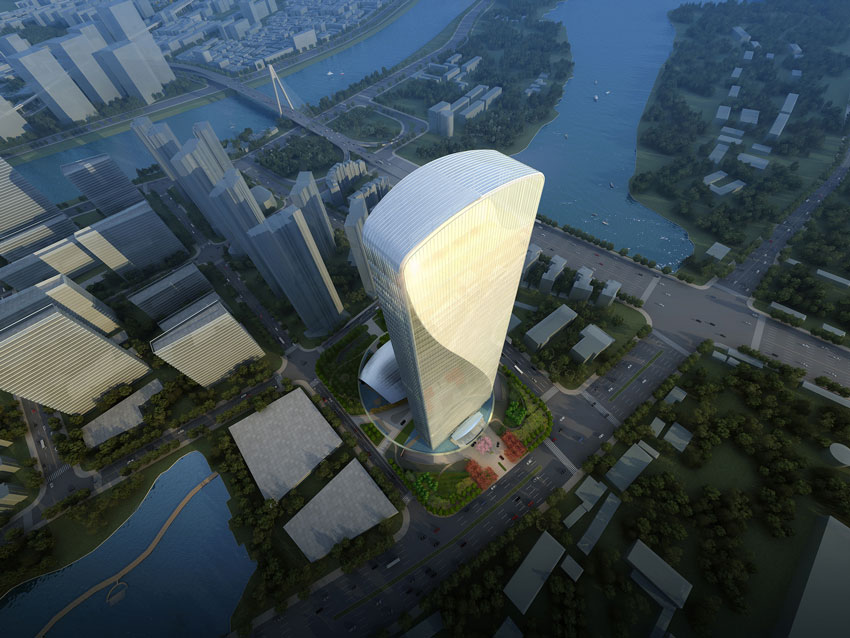
The cultural importance of Moon Lake and the city’s two rivers are emphasized on Qintai International Tower's 25,863 sm site by a series of pools and other water features that surround the tower and podium. The water features are also performative elements of the design, making the air feel fresher to building users in Wuhan’s hot climate. Water for these elements will come from stormwater and/or recovered condensate from the complex.
Other sustainable features being explored for the complex include: Solar hot water roof panels; A high-performance exterior wall featuring passive shading and vertical fins on the east and west facades; An operable louver system with internal shading blinds that are responsive to the solar path; Natural ventilation systems; Storm water and condensate collection systems besides Natural filtration through landscape features.

